The musings of a plant fanatic
by Maurice Wilkins
If I’ve learnt anything from my years as a professional gardener in the west of Scotland it’s this; the world is full of amazing plants which enjoy - or at least tolerate - our comparatively mild climate, and yet very few keen gardeners grow them!
Scroll down to see ‘Plant of the month’!
So why is this? Almost certainly because they don’t know about them! Very few garden centres, in particular those owned by large companies, grow much outside a limited range of plants and it’s not unusual to find the same plants for sale in Oban as it is in Canterbury or Birmingham. OK, many special plants are what are sometimes known as ‘plantsman’s plants’, which suggests that they are unlikely to sport huge brightly coloured double flowers and bloom from February to November. It’s possible that their charm may lie in the fact that they are different, they come from strange places, or they are simply rare - or sometimes a combination of everything!
Fortunately for the gardening fanatics among us there are many smaller nurseries scattered around the UK which are run by equally fanatical growers, and all you have to do is to find them! In my youth it would have been difficult to track down the suppliers of the rare and unusual, but in these Internetical days - if there is such a word! - there’s no excuse. Well I suppose there is - you can’t look for plants if you’ve never heard of them.
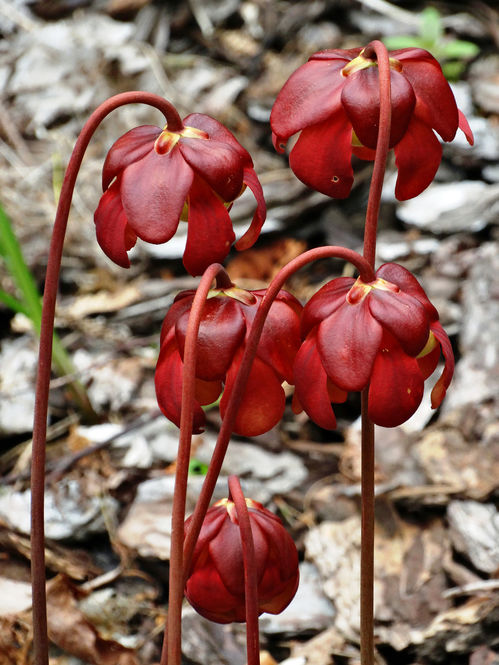
In this blog I’m going to have a go at describing a number of plants which I’ve grown in my time in Scotland’s west, mostly outsiders but occasionally insiders, for which I’ve had to go a little further than the local garden centre. They may not all be beautiful - in fact some might be weird! Watch this space for ‘Plant of the Month’!
June
Plant of the Month - Metrosideros umbellata
Many of the non-native plants that we grow in our gardens have become so common that they don’t generally invite comment - Buddleja, Pieris, Rhododendron and Camellia for example, even if they originate in far off places. But there are others which immediately draw the eye because of their unusual flower shape or colour - Callistemon, Banksia, Telopea, Embothrium and many other exotic plants, including Metrosideros.
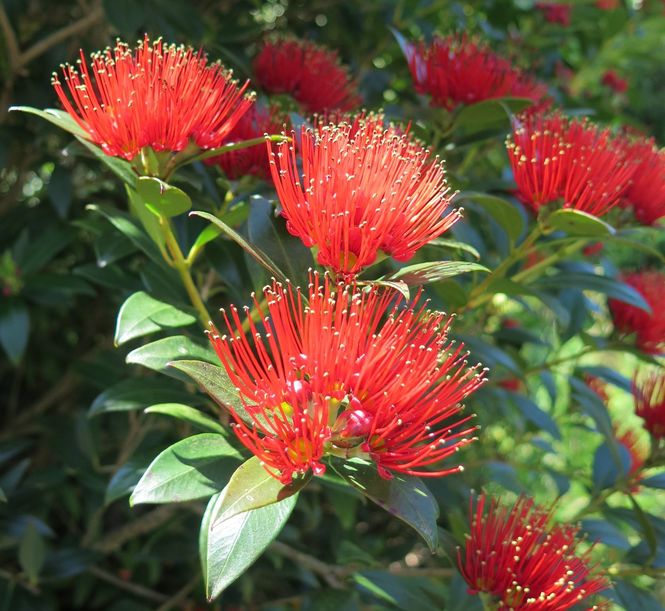
Metrosideros umbellata, my choice for today’s blog, is certainly an eye-catcher. Known as the Southern Rata, it’s probably the hardiest of the genus and one that seemed happy outside at Arduaine, though it’s some time since I’ve seen it. Visitors to Tresco in the Scilly Isles will be familiar with a number of Metrosideros species which grow to tree size there. I grew the Arduaine plant from seed from a shrub in the garden at Inverewe, so it had obviously flowered there! There are also good examples at Logan, Achamore and other coastal gardens.
It’s an evergreen shrub in the family Myrtaceae, or a sizeable tree in its native habitat in New Zealand, growing to 50ft or more. How tall it will grow on Scotland’s west coast remains to be seen - the Logan and Achamore specimens are already quite impressive trees. There’s no doubt that it does need a reasonably mild climate, and would enjoy full sun up here.
The long, scarlet stamens give the flowers their striking colour in summer - the abundant nectar attracts many native birds and is a source of local honey along the west coast of New Zealand’s South Island. The foliage is attractive too - shiny, pointed and dark green, with new growths a beautiful coppery colour. Certainly one to try if you’re looking for a touch of exotica in your garden!
May
Plant of the Month - Primula vialii ‘Alison Holland’
I’ve always enjoyed growing primulas and had a large collection at Arduaine, but I well remember many years ago seeing one that was new to me - Primula vialii, otherwise known as the Orchid Primrose, the Chinese Pagoda Primrose or the Red Hot Poker Primrose. I first saw this plant growing at Logan Botanic Garden and immediately thought - I must have this! Originating from wet meadows or near water in high valleys of SW Sichuan and northern Yunnan in southern China, it’s unlike any other primula and seems to be a rather short-lived perennial - or maybe I didn’t give it the conditions that it required. I grew it on and off over the years - such a amazing plant! I imagined having a huge bed of them, but never managed that. I rarely remembered to grow more from seed and would end up with none!
Then one day at the Gardening Scotland show I noticed something even more impressive - a white form by the name of ‘Alison Holland’. This wonderful cultivar originated as a chance seedling in 2011 in the Northumberland garden of John Holland, who named it after his daughter-in-law. I immediately bought three and they flowered wonderfully that first year. They didn’t appear the following year so I bought three more. Same again! After losing them for the third time I gave up, but writing about ‘Alison Holland’ has made me determined to succeed, so maybe I will try again! They don’t produce seed and are propagated by division, or by tissue culture. Enjoying a moist but well-drained soil in partial shade they ought to succeed in the west of Scotland.
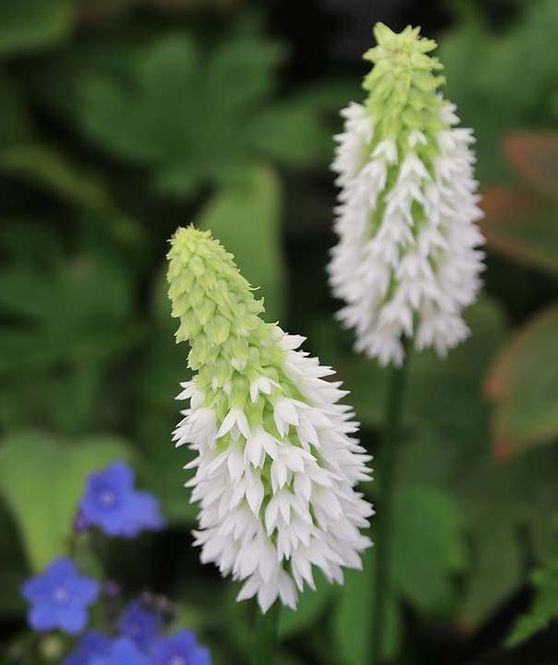
I’d like to think that out there somewhere is a grinning gardener who has a huge bed of this striking plant! If you read this, please tell the world how you achieved it!
April
Plant of the Month - Echium candicans
You might be familiar with the tall spikes of Echium wildpretii or Echium pininana, those monocarpic plants from the Canary Islands that are sometimes seen in warm gardens. They grow first as a large leafy rosette and when they reach maturity they produce magnificent tall spikes of blue or pink flowers - and then die. I did manage to flower them at Arduaine once or twice and they pop up at An Cala on the Isle of Seil too.
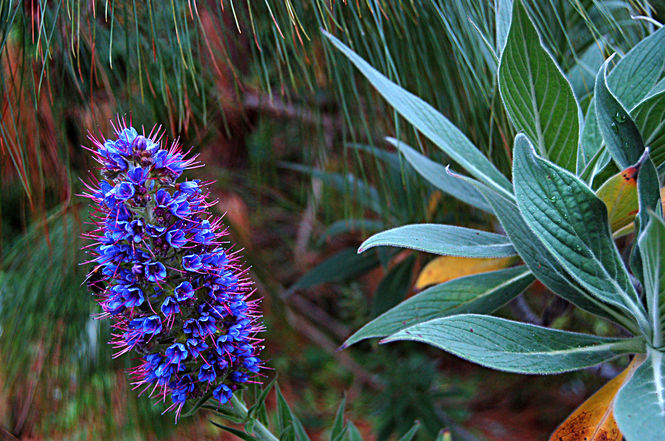
However, if you have a warm spot in well-drained soil then you should try Echium candicans, from Madeira. This species is a true shrub and the specimen I grew at Arduaine survived for many years, eventually producing huge numbers of those amazing short spikes of bright blue flowers. I grew it in a well-drained bed behind a retaining wall in full sun, but having said that, I grew some from seed last year and lost them in the first frost - they were probably too young to be let out on their own and need to be protected for a few years! I have a couple in my unheated greenhouse at the moment and will attempt to grow them on to flowering size somehow! I never said it would be easy!
I’m not sure where I first met this species; it may have been in Madeira, or possibly at Logan. I was convinced at the time that this species grew at higher altitude on the island and that the similar species, E. fastuosum, grew down at sea level. It seems now that they’re considered synonymous.
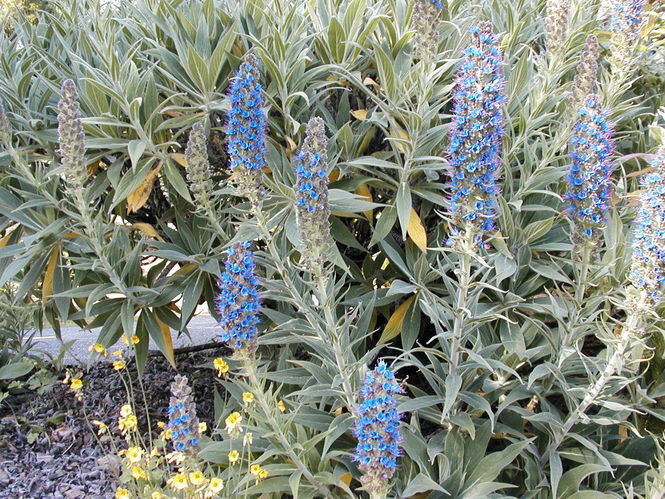
Commonly called the ‘Pride of Madeira’, the RHS describes them as ‘perennial sub-shrubs’, but my plant grew to four or five feet and was totally woody. You need patience and a bit of mollycoddling to succeed with this exotic beauty, but if you manage to flower it you will be really chuffed! Why not give it a go!
March
Plant of the Month - Hippeastrum x acramannii
After a spell of rather unpleasant weather with plenty of wind and rain, it’s good to be thinking ahead and hoping that spring is not too far away! When I began this blog I did wonder if I should talk about plants that were in flower at the time of writing, but decided that winter would be a rather quiet time, blog-wise! So it became a random list with plants to look forward to at different times!
Maybe it’s time for another bulb. I think we’re all familiar with the popular hippeastrums which are often seen for sale in supermarkets and garden centres, usually in the autumn. Pot them up and before long a tall stem with a couple of large flamboyant flowers will grace the sitting-room table. Of course I can’t let an opportunity go by without explaining that hippeastrums are usually sold as amaryllis, which is incorrect. Amaryllis belladonna is a single species of bulb from South Africa, whereas Hippeastrum is a Central and South American genus with some 90 species and more than 600 cultivars! OK, we’ve got over that so I’ll continue!
You probably enjoy a Hippeastrum in the house, but did you know that there are a few cultivars that can be grown outdoors? Most of these are on the edge of hardiness, but the one that I’ve grown outside and which is reputed to be the hardiest is Hippeastrum x acramannii, a hybrid of debatable parentage. I grew this on the rockery at Arduaine for many years and never bothered to mulch or protect it during the winter. Not a plant for a cold garden, but give it a moist but well-drained and sheltered spot in a milder garden and it should do well.
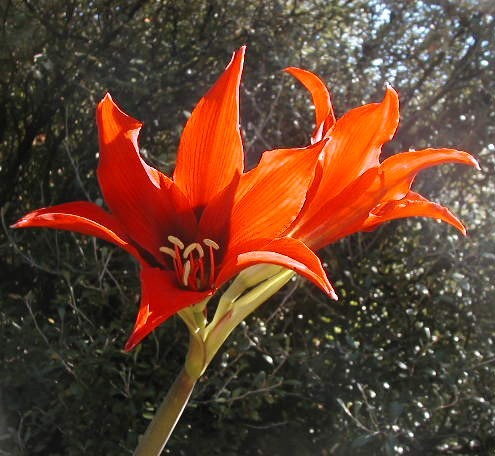
Twin scarlet flowers are produced on 50-60cm stems in late spring or summer and will surprise visitors to your garden - they look so much like houseplants! Go for it!
February
Plant of the Month - Callistemon citrinus ‘Splendens’
There are many hardy shrubs which have a similar look about them - even if they’re unusual, they don’t always stand out. I can’t remember where I first spotted a Bottlebrush, but I immediately thought that it was different, with flowers shaped like a - well, a bottlebrush!
When I arrived at Arduaine Garden in 1992 I noticed a medium-sized shrub with small, pale yellow bottlebrush flowers. It was labelled Callistemon sieberi (not any more it’s not!) and is said to be the hardiest of the genus and commonly known as the Alpine Bottlebrush. It’s not particularly showy so I was delighted to hear about a more spectacular species with red flowers, Callistemon citrinus ‘Splendens’ and quickly got hold of a plant. I’ve grown it ever since and have one in my Oban garden.
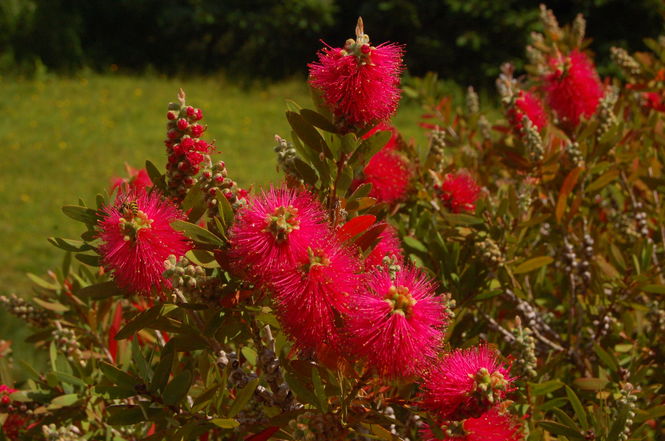
You’ll be delighted to discover that the genus Callistemon was originally known as Metrosideros, and is now known as Melaleuca! I don’t care - it will always be Callistemon to me. I’m far to old to put up with changes every time I check plant names on Google! Maybe I should change my name to Meriwether!
So in real life Callistemon citrinus is Australian, native to the coasts of New South Wales, Victoria, and Queensland. The variety ‘Splendens’ was raised at Kew from Australian seed and is generally the most reliable to plant outdoors, growing usually to a metre or two. None of my plants have ever suffered from the cold here in the west. Beautiful crimson bottlebrush flowers are produced in summer and the narrow, pointed evergreen leaves smell of lemon. It seems happy enough here in an open situation and produces cylinders of small cup-shaped seed pods along the stems, which are also quite distinctive.
All-in-all a very worthwhile shrub to grow and one which will have passers-by looking over your garden fence in amazement!
January
Plant of the Month - Lathraea clandestina
We’ve had representatives of most plant types in this blog - trees, shrubs, climbers, perennials, ferns, succulents and the many subdivisions of most of these. One plant type that hasn’t yet appeared is the parasite, which very generally speaking is one that takes its nourishment from another plant; they are found in many of the types listed above. It’s a complicated subject, so for now I’ll simplify it by dividing it into two - hemiparasites, which have chlorophyll, and holoparasites which don’t!
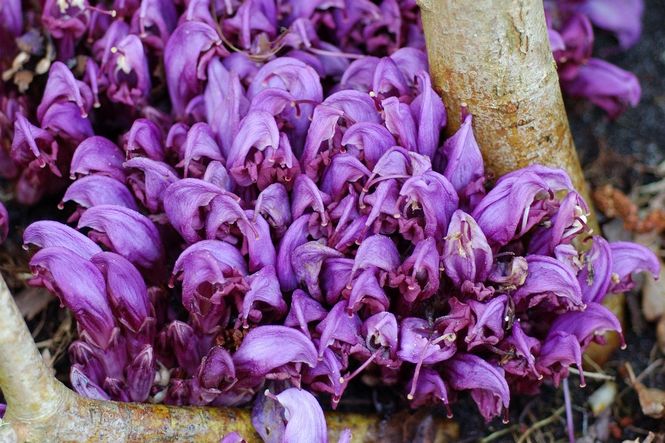
So for this month we have a holoparasite and it’s Purple Toothwort, Lathraea clandestina. I’d not heard of this plant until I arrived at Arduaine Garden in the early 1990s; there was a considerable clump growing beside a path and in springtime it made a most attractive patch of purple groundcover just a couple of inches tall. It’s a native of Western Europe, though not Britain - we have a cream-flowered native species, Lathraea squamaria - but was introduced to Kew at the end of the 19th century. It can grow on the roots of a number of trees and shrubs, but particularly willow, alder and poplar.
It’s generally quite hardy, though the flowers have been known to be damaged in exceptionally frosty spring weather apparently. I’ve not tried to propagate it, though now I wish I had! The most successful way is probably by digging up a small clump - if you have access to the plant, of course - and replanting it close to the roots of a potential host. It can also be grown from seed, by sowing it directly over the root system of the chosen host. Growing from seed is a slow process, and it can be ten years before the plants flower. Which method you choose depends on your age - personally I would go for the first one!
Like so many of the plants described in this blog, it’s not hard to grow but just requires a little more effort. It’s certainly a very eye-catching plant and well worth that extra effort!
2025
December
Plant of the Month - Fuchsia ‘Corallina’
One of the many things which make plants exciting, to me at least, is the range of stories behind them. There can’t be many gardeners who don’t grow, or who haven’t grown, a fuchsia. I was amazed to discover that apart from the 108 fuchsia species, there are apparently some 21,000 fuchsia cultivars! Botanist Leonard Fuchs, after whom the genus was named, would have been delighted, I’m sure! Some well-bred gardeners in the UK were apparently unhappy at how much the name sounded like a common swear-word, so decided to pronounce it ‘few-shia’ in order to avoid offence! So they say!
There are a number of stories concerning the first introduction of a fuchsia to the UK. I recently popped in to a riverside pub, The Prospect of Whitby, in Wapping, London, where I noticed a plaque describing how a fuchsia was first brought home. It states “The first fushcia (sic) was discovered in 1696 in San Domingo and introduced to England via this pub. Brought in by a thirsty traveller from the ‘New World’, the first plant was traded here for a noggin of rum.” Whether or not this is true, I don’t know, though did write to point out the incorrect spelling, but received no reply!
This month’s beauty, Fuchsia ‘Corallina’, is a low-growing plant, spreading outwards rather than upwards - it grows to around 50cm by 150cm. It’s a hybrid of Fuchsia ‘Exoniensis’ and F. montana - ‘Exoniensis’ itself is a hybrid between F. cordifolia and F. globosa. So that’s an interesting story to begin with! It was produced by the nursery of Lucombe and Pince of Exeter, in 1844, so it’s been around a while.
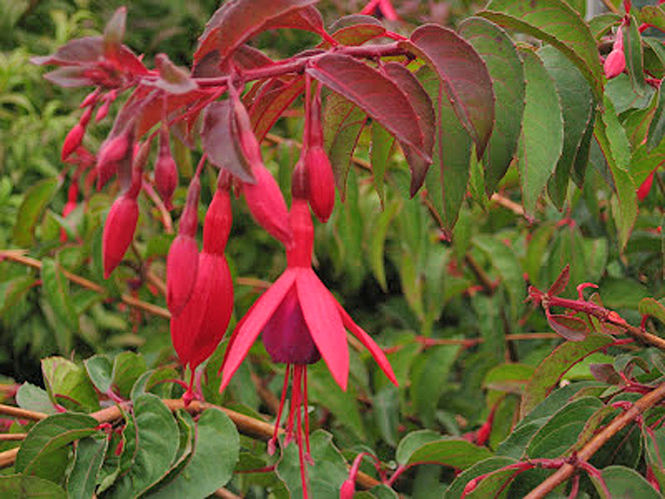
The typical fuchsia flowers have scarlet sepals and purple corollas and new shoots are burgundy-red. It’s a largely hardy plant and in my experience doesn’t get cut to the ground like many other cultivars. It’s an easy plant for moist but well-drained conditions, and enjoys a sunny or partly shaded site. You’ll love it!
November
Plant of the Month - Apios americana
A few years ago I spotted this plant on the website of a nursery specialising in unusual vegetables and rather liked the sound of it. A hardy, tuberous, nitrogen-fixing legume, it’s native to the eastern side of the USA and southern Canada and I’d never heard of it! This meant that according to my own frequently ignored rule - only buy a plant if you’ve never heard of it - I could legally buy it!

A perennial climber, it will grow to a couple of metres or so on a suitable support, then die down as winter approaches. Native American people used the tubers much as we now use potatoes, and the flowers produce edible beans, though generally only in the southern part of the range.
I planted my tubers in a large pot with a triangle of tall canes to support the hoped for stems and before long I was rewarded. The twining stems with their handsome pinnate foliage grew almost to the top of the canes, though no flowers were produced. When the stems had completely died down I tipped the tubers out and found enough spare to give some to a friend, though not really enough for a good meal!

The plant has withstood several winters in the pot out on the deck, so seems totally hardy here. If it grows in Canada then it should be! This year a number of slender side-shoots emerged from the twining stems each sporting several small flower buds. Although it’s supposed to flower from early summer onwards, it seemed unlikely that these buds would open as late as October, but I hoped that an Indian summer might encourage them - as well as making the plant feel at home! I’d love to have seen the pink/purple/brown flowers, but unfortunately along came Storm Ashley and gave my poor old Apios a thorough thrashing!
And just in case you’d rather have a common name, then you can try groundnut, American groundnut, potato bean, hopniss, Indian potato, hodoimo, American-hodoimo or cinnamon vine!
October
Plant of the Month - Kniphofia rooperi
Plants in the genus Kniphofia, commonly known as Red Hot Pokers, are not particularly rare or unusual in gardens - I grew quite a number of different types at Arduaine. There are around eighty different species, all native to southern Africa, and hundreds of cultivars in many different colours - red, orange, yellow, green and even brown and pink. I don’t think there’s a white one, but several come very close. They’re naturalised in several countries, and one species, Kniphofia uvaria maybe, is often seen growing above west coast beaches.
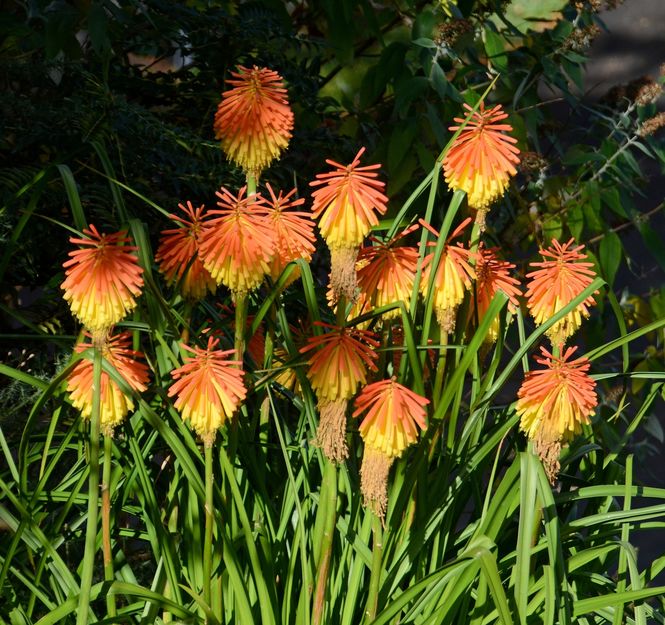
There’s a height for every garden too - from twenty inches to nearly seven feet in old money, apparently. So how on earth do you choose which one you’d prefer to grow? I rather fell for Kniphofia rooperi; its flowers are shorter and plumper than many others and it flowers here in September and October. It may not be as commonly available as some, but it’s well worth seeking out. It was the only one that I brought with me when I retired and it flowers well in my Oban garden.
They generally prefer well-drained soil in a sunny place, and the only problem I’ve found with this plant is the damage that can occur to the evergreen foliage during a windy winter. Last year I had to cut it to the ground in the spring, but it re-grew well and is flowering now as I write. Back at Arduaine I grew it next to a blue lacecap hydrangea and I think I’ll try to do the same here as I have a couple of Hydrangea macrophylla ‘Zorro’ looking for some equally colourful company!
The genus Kniphofia is named after Johann Hieronymus Kniphof, an 18th-century German physician and botanist. I think it’s probably just as well that the name of the genus was based on his surname and not the middle one!
September
Plant of the Month - Geranium palmatum
There can’t be many gardeners who have never heard of the name Geranium. I suppose that the popular window box geranium is the best known, but of course these are really pelargoniums.
But back to real geraniums. There are over four hundred species, which are either annuals, biennials or perennials, and it’s quite amazing to find that over 100 species are grown in UK gardens, as well as some 600 cultivars! So why should I pick out just one species, Geranium palmatum, the Canary Island geranium, when there are so many to choose from?
It’s because I’ve grown to love it over the years, both as a wonderful foliage plant, and also because of its huge, hazy sprays of pale pink flowers. It’s not really the Canary Island geranium of course (You probably expect me to criticise its name!) as it’s native to Madeira, which is not part of the Canary Islands, but we’ll let that go! The danger of common names! It’s sometimes confused with Geranium maderense, but this species, though maybe more dramatic, is less hardy. I brought some plants home from Cornwall a couple of years ago, but lost them in the first winter.
In spite of its origin it’s pretty hardy in the milder parts of the UK, and here on the west coast, both at Arduaine and in Oban, it’s overwintered in most situations. There’s some disagreement as to its hardiness, some nurseries quoting a minimum of minus 5, others minus 10, but I’ve not lost any here. I think of it as one of these ideal plants - handsome evergreen foliage, attractive long-lasting pink flowers and the ability to seed around without ever becoming a nuisance. It prefers a situation out of the hottest sun, but that’s not a major problem here!
To quote plantswoman Margery Fish ‘When in doubt, plant a geranium.’ But I could add, ‘If you’re feeling a little more adventurous, plant Geranium palmatum’!
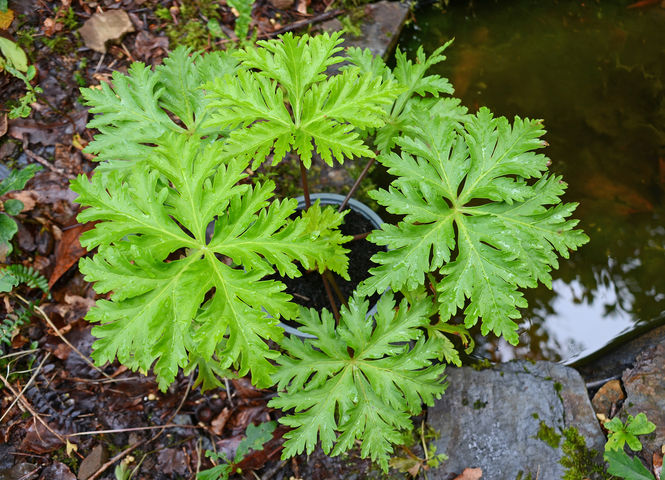
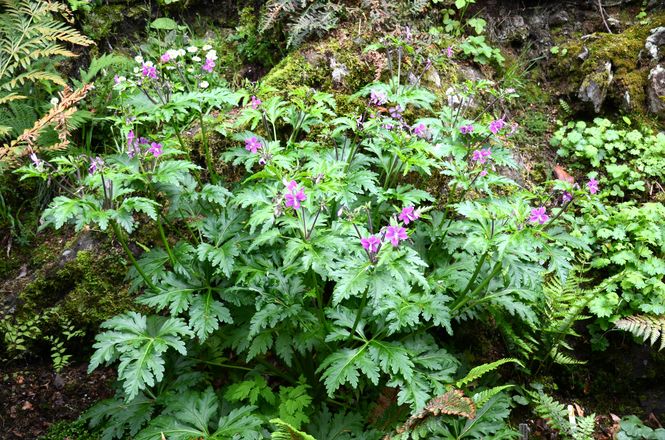
August
Plant of the Month - Fascicularia bicolor
I haven’t talked about bromeliads for a while, so thought it time to have another go. We haven’t yet succeeded in growing pineapples outdoors in Argyll, so I hope that Fascicularia bicolor will do instead. It seems totally hardy here.
This genus is native to the Andes of Chile and consists of only one species, F. bicolor, though that species has two subspecies, F. bicolor subsp. canaliculata and F. bicolor subsp. bicolor. OK, that’s the technicalities over!
I first saw this plant growing on a bank on arrival at Arduaine Garden in 1992. It was the form F. bicolor subsp. bicolor, which has broader leaves than its relative, though just as spiky. It’s a rosette-forming plant and quite obviously a relative of the pineapple.
I was delighted to see this vicious creature while in Chile back in 2005. I learned that the two subspecies grow in different habitats, the first in trees and the second on rocks, though I’m not sure just how insistent they are on this! As they grow, side-rosettes expand the clump into a mound. While walking through a Chilean forest one day we came across a monster which had obviously broken free of its tree host and lay on the ground - it measured 10ft across! In the good old days, of course, one would have ordered one’s servants to carry it down to the coast where it would have been transported back to the UK and winched up into a large tree on one’s estate. All we could do was to gawp at it!
When a rosette decides that it’s time to flower the lower part of the foliage turns bright red, directing the pollinators to the small blue flowers nestling below. In Chile the flowers are apparently pollinated by hummingbirds.
A spectacularly different plant to grow on a sunny bank, in either form. Only one thing you have to remember - if you put your hand down into the rosette, you may never get it out!
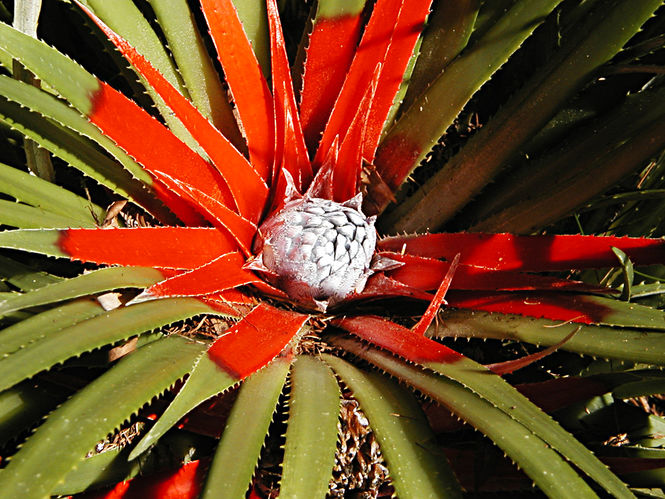
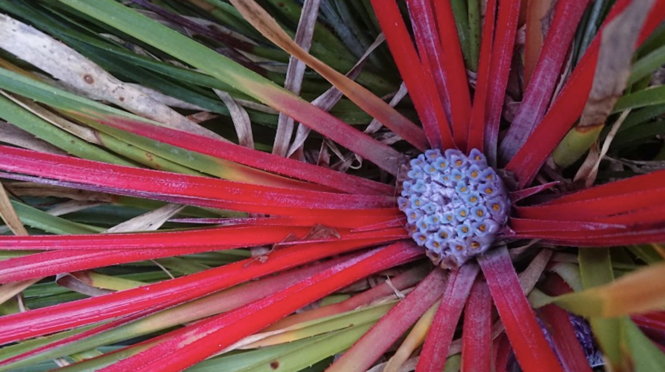
July
Plant of the Month - Cardiocrinum giganteum
One of the many special moments during my first adventure in Nepal, in 1990, was when I walked into a woodland clearing and found it full of this amazing lily, Cardiocrinum giganteum. We were too late to see it in flower, but at least I was able to collect seed. This Giant Himalayan Lily, first described around 1825 as Lilium giganteum, can grow to more than two metres with huge, glossy heart-shaped leaves, but it’s not a plant for the gardener in a hurry!
My seed took two years to germinate and a further five years at least for the bulbs to grow to flowering size. Apparently the germinating seed puts down roots the first year and produces shoots in the second year. You’ll no doubt be delighted to know that the species is classified as monocarpic, which means that it flowers once then dies! I missed my first flowering as I’d planted the bulbs in a sheltered spot at Arduaine rather off the beaten track, and my first viewing was of the flowers lying on the ground!
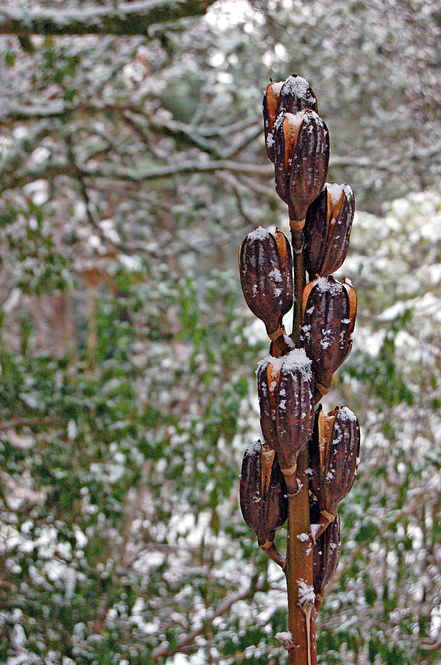
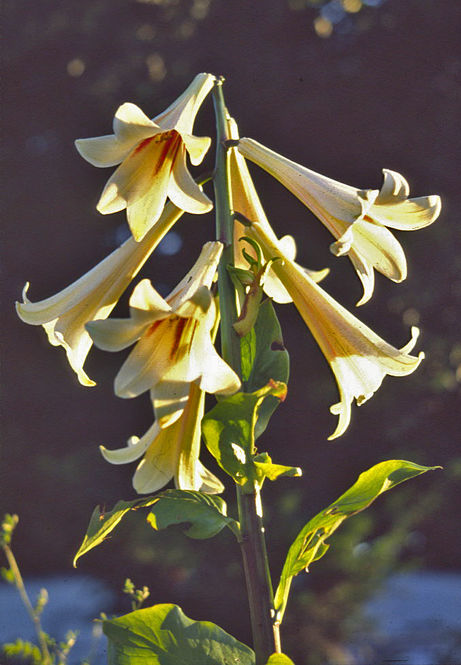
As the huge stems rise they completely use up the stored energy of the bulbs which then die, but offsets are produced which will grow on and eventually flower. In time and with luck there should be a bulb of flowering size every year, but don’t count on it! One of mine flowered at the beginning of June this year, with six flowers on a 1.5 metre stem, but the soil on my bank is rather shallow and infertile.
These Giant Lilies prefer a semi-shady position in the garden with good woodland soil. As an adaptation of the old saying ‘The best time to plant a tree is twenty years ago’, I would say that the best time to plant a Cardiocrinum is three years ago! But now is the second best time!
June
Plant of the Month - Luma apiculata
The name ‘myrtle’ is commonly used for a great number of trees and shrubs in the family Myrtaceae, but strictly speaking only those classified as ‘Myrtus’ should be called by that name. It was when I took up my post at Arduaine Garden that I really became aware of the family as there were two species in the garden, Myrtus luma and Myrtus lechlerana. Both were small trees, the first flowering in summer and the second in spring.
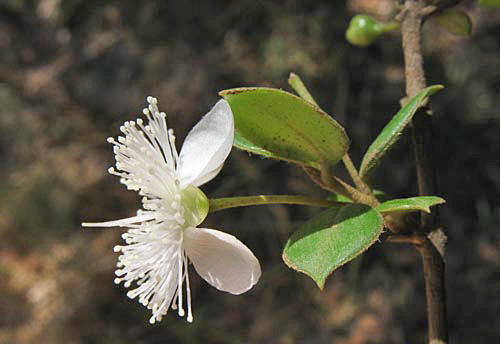
OK, you know what I’m going to say! Yes, the taxonomists soon got to work on the genus and Myrtus luma became Luma apiculata. Fair enough I suppose, until I discovered that Myrtus lechlerana was to be known as Amomyrtus luma! The same name for a genus and a species? Confusing, or what!
Oh well, the names may change, but the plant remains the same. Luma apiculata is usually described as a large evergreen shrub or small tree, though apparently it can grow to 15 metres. Its hardiness is also in doubt, though the plants at Arduaine were never damaged and occasionally seeded around. It would be best to give it a reasonably warm spot. The most striking feature of the tree is its peeling cinnamon bark which really stands out, so it’s worth planting it where the trunks are visible. Copious white, fragrant flowers are produced in summer and the black berries are edible, though I’ve never tried them. The small leaves are fragrant too.
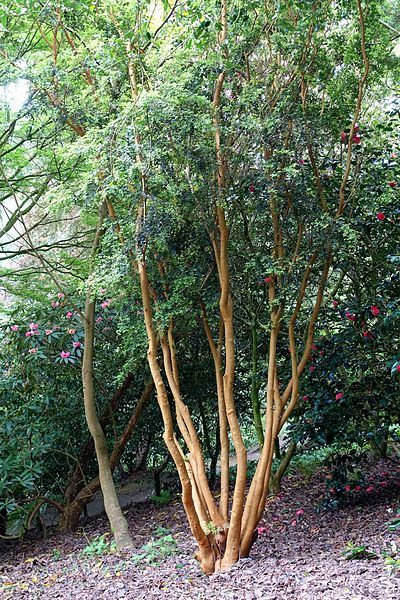
Luma apiculata is native to the Andes, between Chile and Argentina. It really is a spectacular shrub or tree and ought to be grown more widely. Very commonly grown in SW England, but that’s all the more reason for trying it in the warmer parts of Scotland! Go for it and be the envy of your neighbours!
May
Plant of the Month - Mitraria coccinea
When I arrived to take up my post at Arduaine Garden I was to discover many plants that I was unfamiliar with. It’s very exciting to stand in front of a plant and think ‘Now what can this be?’
One shrub that I hadn’t seen before turned out to be a native of Chile and Argentina by the name of Mitraria coccinea. This is a softly evergreen shrub of a fairly lax habit which was growing thickly over the ground and also to some 20ft up adjacent mossy tree trunks. Many authorities describe it as a loose-growing shrub, others that it grows to 2 meters, but it’s capable of climbing to greater heights in the areas which it prefers, which seem to be the milder, moist woodland gardens of the west of the UK. I’m sure that others will disagree, but this is my experience of it.
I don’t know the origin of the Arduaine plant, which I now have growing in my Oban garden, but the downy tubular flowers, 2-3cm long and borne over a long period from spring into summer, are distinctly orange. There are a number of cultivars on the market - ‘Clark’s Form’ is said to be orange, whereas ‘Lago Puyehue’ is described as scarlet. Another form is known as ‘Lake Caburgua’ the flowers of which are described as bright scarlet, but the pictures make it look very orange to me! Maybe I should grow a plant of each and compare their flowers!
Whichever form you choose, you’ll not be disappointed. I’ve never seen it damaged by frost here on the west coast, but I’m sure it will survive in most gardens given a cool, sheltered, damp spot. Plant it at the base of a mossy tree - then sit back and await results!

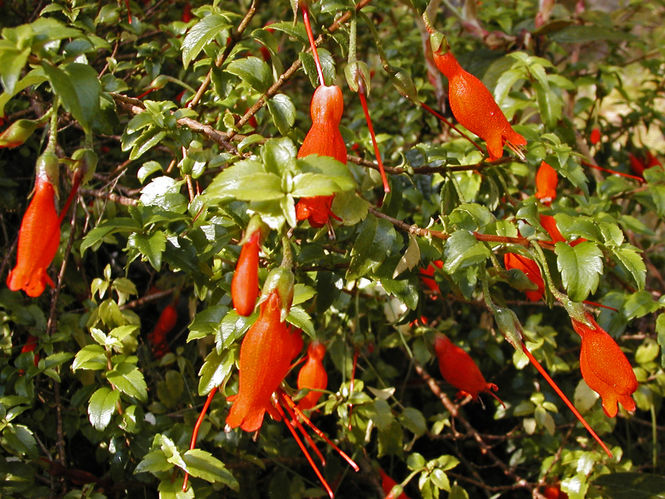
April
Plant of the Month - Arisaema griffithii
One of the many outstanding memories of my first trip to the Himalayas in 1990 is the sight of hundreds of these remarkable aroids growing in the shade of an extensive woodland in Nepal. We were outward and upward bound at the time, but when we returned along the same route some time later I was astonished to see that almost without exception, the plants had been dug up and the tubers were lying scattered over the woodland floor. Our Sirdar, Chheduk Man Lama, told us that this vandalism - to us anyway! - was caused by a roving band of black bears who fancied a nibble! Even though I regretted the damage I would have loved to see them in action! I found a partially chewed tuber and smuggled it home, but in spite of liberal doses of fungicide it rotted away. Bear saliva must be toxic!
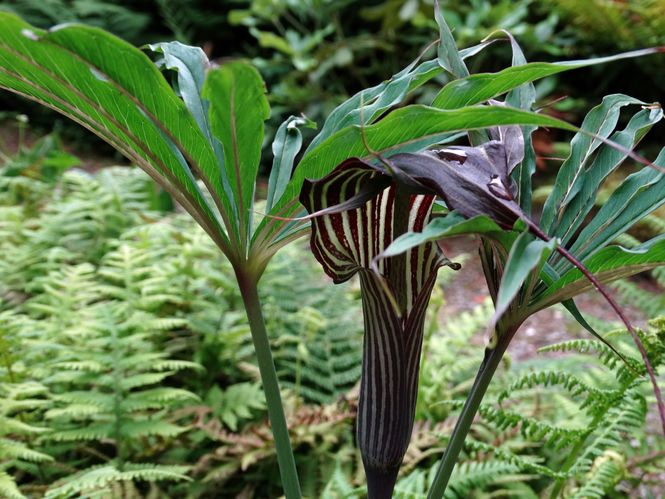
Back home I bought a tuber from a nursery and planted it behind my house at Arduaine Garden. It appeared most dramatically in the spring - a huge, plump shoot which suddenly explodes into dark green foliage, followed by several arum-type flowers. When I retired I brought my plant with me and replanted it at the bottom of my slope beside the road, where it surprises passers-by. As the flowers die down a stumpy spike of red berries takes over, by which time the foliage is already dying back.

A native of the eastern Himalayas, it can grow to a couple of feet tall, though its striped and hooded purple flowers crouch down at the base of the plant. An easy plant to grow in a shady site and one that will never cease to amaze you, as it does me! Go on then!
PS Don’t forget to protect your plant from black bears!
March
Plant of the Month - Asteranthera ovata
If I had to choose a favourite plant, then this one could be it. I wonder if I’ve said that before! Favourites come and go, as they do with books, music and many other things. But this one is special.
Asteranthera ovata is native to the moist forests of southern Chile and Argentina, where it’s known as Estrellita del bosque, or Little Star of the Forest. It’s an evergreen climber, reasonably hardy here, and is generally seen scrambling over mossy rocks and tree stumps.
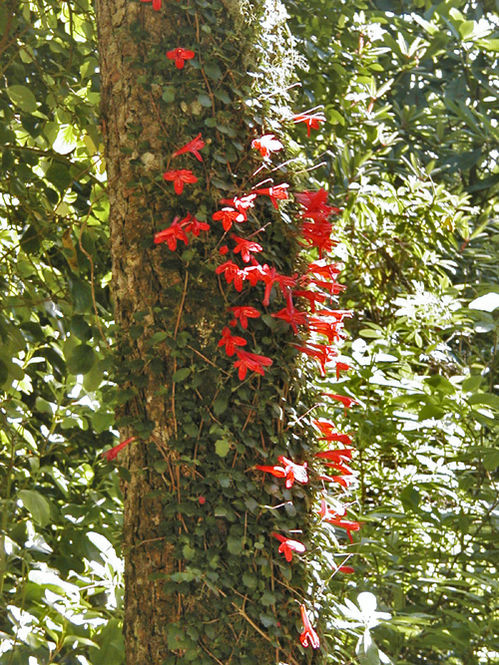
As long as the site is damp it enjoys a bright situation, and can climb to several metres up tree trunks. I remember seeing this for the first time when I came to Arduaine Garden back in 1992, where it was adhering to moss-covered boulders up in the woodland. The flowers, which are produced in spring and summer here, are sometimes described as red, sometimes as pink and once I saw ‘fuchsine purple’. In reality, a deep pinky-red!
I love plants in this family, and even more, I love plants which attach themselves to cool, mossy surfaces. I remember a visitor to Arduaine once criticising me for planting the Chilean climber Mitraria coccinea, which has orange flowers, on a tree on the opposite side of the path to the Asteranthera, as they flowered at the same time and the colours clashed. I was absolutely delighted, on a visit to Chile in 2005, to find these two plants actually growing together on the same tree! If Nature doesn’t mind, then neither do I!
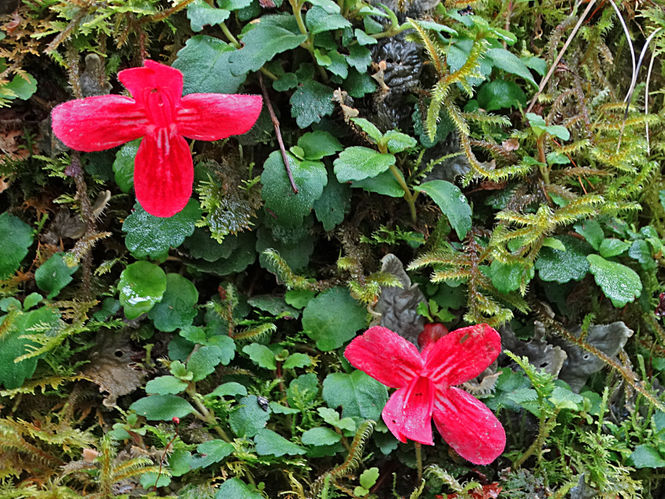
I’ve not seen it produce seed here, but it’s very easily propagated from cuttings, so if you have a cool, mossy place in your garden then do give it a go!
February
Plant of the Month - Blechnum fluviatile
It’s been a while since I’ve picked a fern for this blog, so I’ll try a small one that’s growing in a raised bed just opposite my kitchen window. I used to grow this pretty fern in the corner of a bed down by the pond at Arduaine. It’s reasonably hardy and the plant in my Oban garden has survived -7°C this winter with only some minor browning of the frond margins
It’s a native of New Zealand and S.E. Australia, including Tasmania, possibly further afield. I always check for current naming as there are so many changes - one of my favourite moans! Various websites give synonyms such as Blechnum nudius, Lomaria fluviatilis, Lomaria rotundifolia, Spicanta fluviatilis and Stegania fluviatilis! I notice that some New Zealand websites are now calling it Cranfillia fluviatilis, which might be the correct name of the future! Most species in the genus Blechnum have now been moved into other genera, but fortunately old names usually persist outwith the taxonomical fraternity!
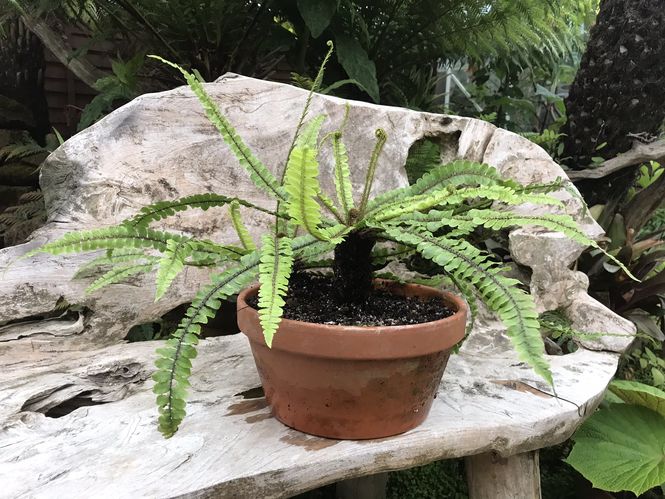
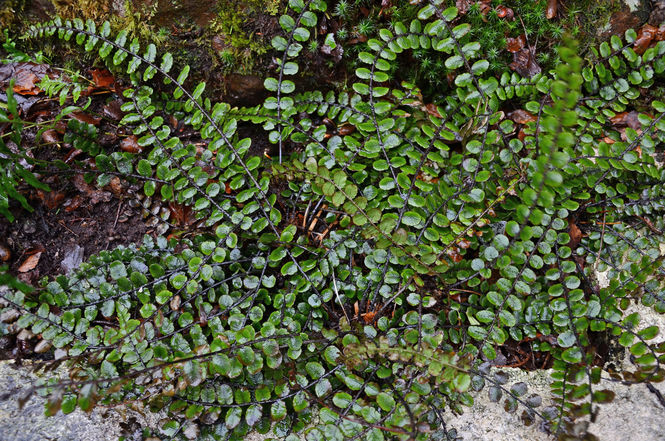
But back to real gardening! This low-growing evergreen fern grows close to water in the wild, hence the specific name ‘fluviatilis’, signifying a connection to a river. This suggests that a moist site is best, out of hot sunshine, should you be lucky to have some! It forms rosettes of slender fronds, lined with rounded pinnae, with short upright sporing fronds growing from the centre - mine haven’t produced these yet. According to some authorities it will sometimes grow a small, slender trunk - this I would like to see! I’ve found a picture showing this. In the meantime it makes an attractive groundcover in a shady spot.
Just in case you’re an advocate of common names, here’s a selection from various books and websites - Water fern, Ray water fern, Star fern, Creek fern, Crown fern, kiwikiwi, kiwakiwa, kawikiwa and kawakawa. I’m tempted to emulate the chain store suppliers and simply refer to it as ‘Fern’!
January
Plant of the Month - Schefflera rhododendrifolia
I think I’ll begin the new year with a shrub which has long been a favourite of mine. Back in the early 1990s I visited the garden at Baravalla, near West Loch Tarbert in Argyll, home to the more tender collections of plantsmen Peter Cox and Sir Peter Hutchison.
On one of their spring open days I noticed a tall shrub growing in a shady spot at the back of the garden. Unusually this shrub had digitate foliage - leaflets emanating from a central point - very similar to the houseplant Heptapleurum arboricola. I discovered that it was Schefflera impressa, an evergreen native of the Himalayas, and asked Peter Cox if I could take cuttings. He gave it some thought, then told me I could take three, but later in the season. At the due time I returned, carrying a ladder with which to scale the fence - the garden isn’t normally open - and managed to find my way back to the shrub in question and took the cuttings.
I planted one rooted cutting out in a sheltered spot at Arduaine Garden and in time it grew a single stem to some 20ft, flowered and set seed. Unfortunately the following winter it was smashed and uprooted by a falling larch, but pruned back to a stump and replanted it began to regrow, so I hope it’s doing well now. You might not be surprised (!) to hear that the name has been changed, to Schefflera rhododendrifolia, which seems rather odd as it could never be mistaken for a rhododendron!
I now have a couple of its seedlings growing in my garden in Oban. They’re pretty hardy, so if you want to grow something which looks different, this is one to try.
Oh - I nearly forgot! I see from the Kew website that it’s now to be known as Heptapleurum rhododendrifolium!
Suggestions for another name change on a postcard please!
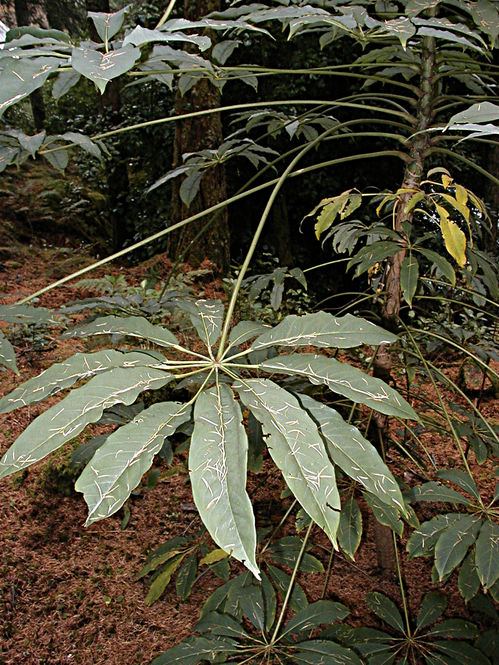
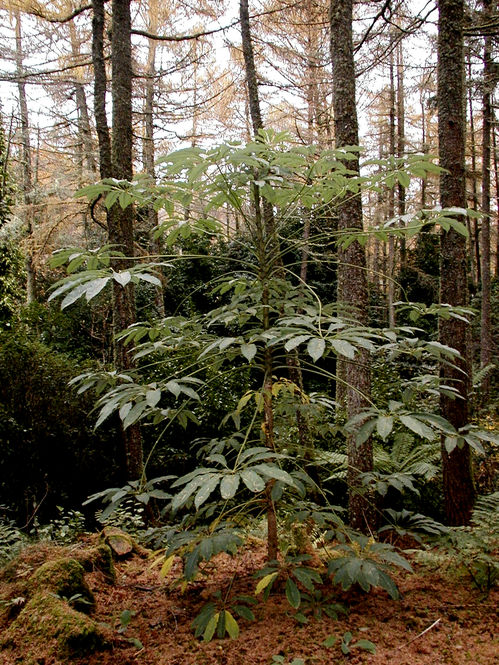
2024
December
Plant of the Month - Erigeron karvinskianus
When I began this blog it was probably my intention to talk about plants which were in flower or otherwise looking good during that month. For various reasons this hasn’t always happened, though this time I can honestly say that the spread of Erigeron karvinskianus in my garden does still have a few open flowers on it! That seems very brave, seeing as it’s a native of Mexico and other parts of Central America and we’ve just suffered a frost of -6°C here in Oban!
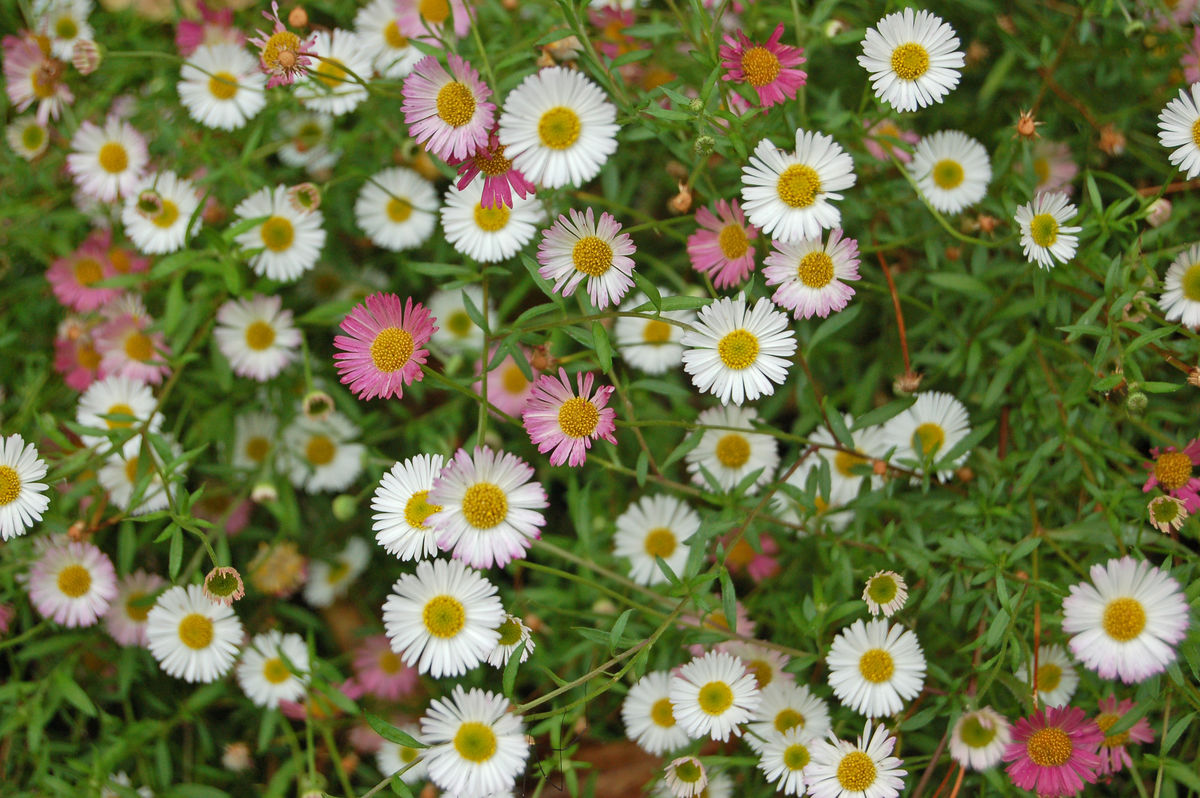
I first saw this plant growing all over the walls of that wonderful Lutyens/Jekyll garden in Somerset - Hestercombe, near Taunton. If you haven’t visited, then you must add it to your to-do list immediately! It’s a formal garden, though filled with a breathtaking range of plants, and this so-called Mexican Fleabane covers the walls in amazing profusion. I remember taking a group of Americans there on a garden tour some years ago and one of the ladies, who considered herself somewhat of a garden designer, remarked that if it was her garden she would immediately remove all of it! I told her that Gertrude Jekyll would not have been pleased!
As you might expect, it’s a lover of sunshine and well-drained places and will seed around gently, but not enough to be a nuisance - as if! Growing to around 15cms, it’s a delicate-looking but tough plant with dainty, narrow foliage and daisy-like flowers which are produced from spring to autumn. They open white and mature to deep pink, and together they make an attractive combination.
It’s a semi-evergreen plant and after a cold winter might need a spring trim, but I’ve always found it an easy and reliable creature on wall tops, rockeries and other open places. Do give it a go!
November
Plant of the Month - Aloiampelos striatula
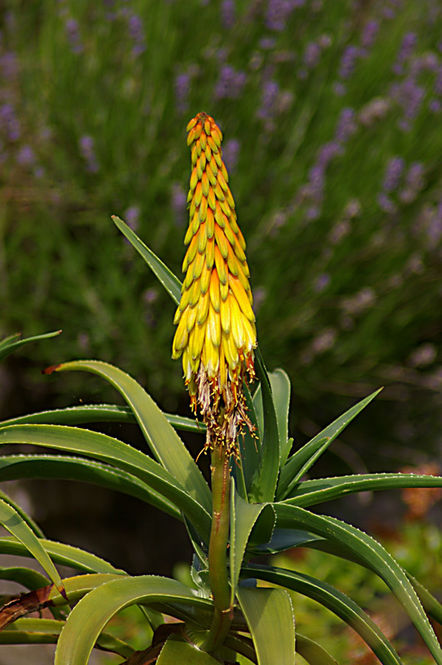
Well winter’s coming on, so let’s have a reminder of summer sunshine and talk about a hardy succulent!
I suppose many people will be aware of the genus Aloe, or Aloë as it’s sometimes spelt. Whatever’s correct, it’s usually pronounced as ‘Allo’. Maybe I should say at this point that in common with so many plant names, just when we think we remember them some taxonomist decides to change them! In this case the genus is renamed and this plant is now to be known as Aloiampelos striatula!
We think of them as houseplants, cacti from the desert, plants that you would never consider growing outside - but maybe we should think again! striatula is a spiky succulent native to mountain tops in the Karoo district of South Africa and is considered the hardiest of the genus. As you might expect, they grow happily at Tresco in the Scilly Isles, but so do many plants generally thought of as tender. I saw them there many years ago - from a distance they might possibly be misidentified as yellow flowering kniphofias until you see the spiky rosettes - and bought a packet of seed.
I grew the seedlings on for a number of years and eventually planted them out on a sunny, well-drained bank at Arduaine Garden where there grew and flowered. Having retired and not wanting to spend several years growing them again from seed I bought three plants which survived in a pot outside the house for a few years - I planted them out in the spring and look forward to seeing them flower in due course!
They certainly add an exotic touch to a garden, maybe on top of a sunny wall or on a rockery. When you sit outside on a summer’s day with your G&T you can imagine yourself on holiday in the Med!
October
Plant of the Month - Begonia grandis subsp. evansiana var. alba
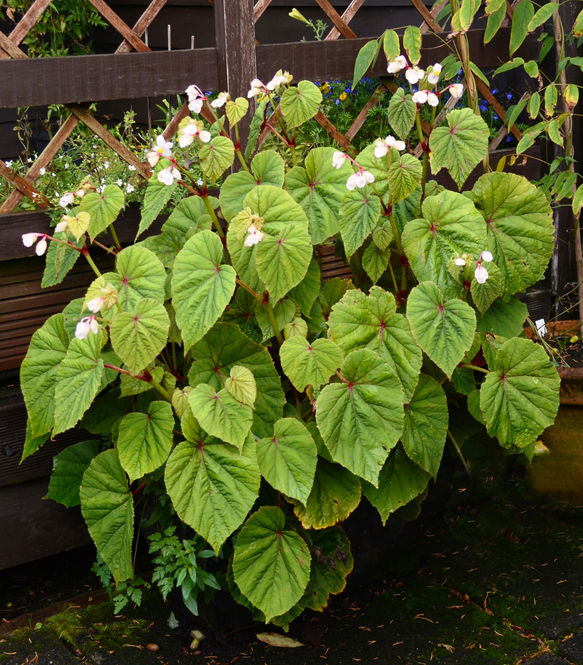
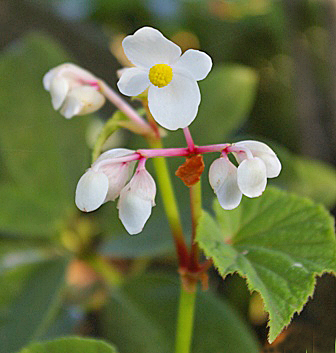
As I write in late September this tuberous begonia is opening its flowers outside my front door. It’s a beautiful plant in spite of its long Latin name! I grew it for many years in the garden at Arduaine and it’s been happy in a trough here in Oban through the last seven winters. It may seem a surprise to find a begonia which is generally hardy, but it’s said to be able to withstand -12°C. It dies down with the first frost and re-emerges in the spring, though it takes its time! It’s quite slow to get moving, but it soon speeds up, and growing next to the wall of the house where it receives sun only during late afternoon it grows to around 70cms.
Native to southern China and Japan, the original species has pink flowers. There are a couple of new pink-flowered cultivars on the market now which are just as hardy and look to be well-worth growing. They all seem to prefer a semi-shady position, though mine didn’t appear to suffer earlier in the year when we had some very hot sunny days.
Very easy to propagate from leaf or stem cuttings. It may not sound very professional to put cuttings in water to root, but I find it works very well with begonias and they produce extensive roots, when they can be potted up. This species is said to produce bulbils in the leaf axils which can be taken off and grown on. I can’t say I’ve noticed this on my plants, but maybe I just haven’t looked hard enough! Must do better! Happy gardening!
September
Plant of the Month - Lilium sargentiae
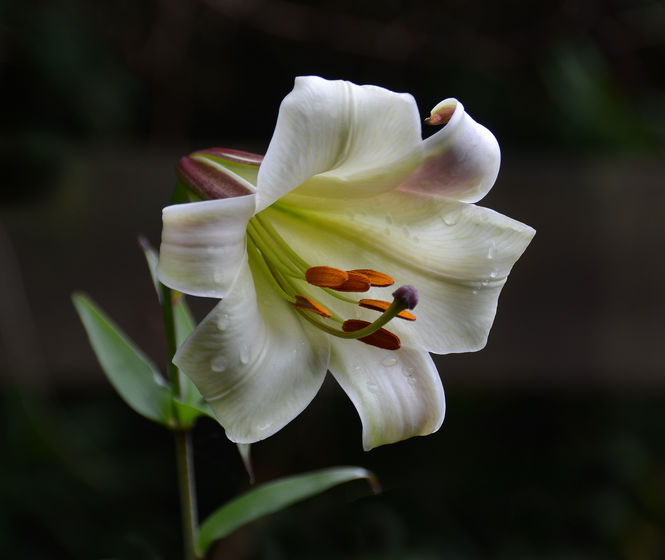
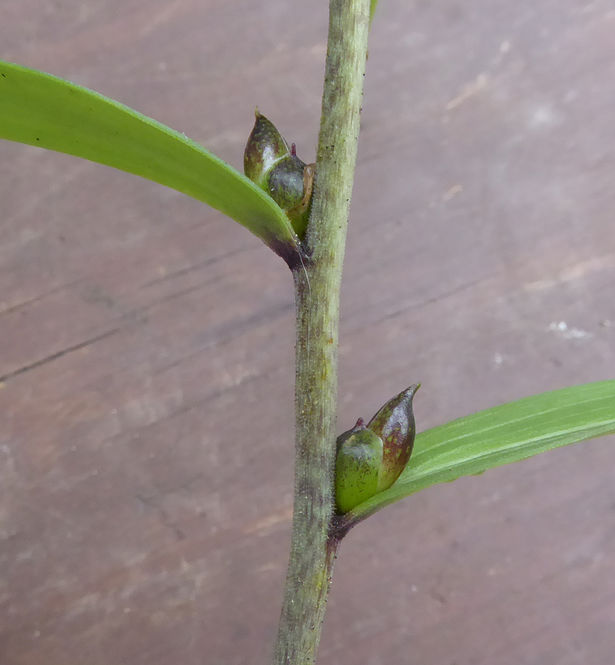
Lilies are common enough, I hear you say - you can buy them everywhere. That could be, but there are many wonderful lily species that you may not see for sale in your local garden centre.
One of my favourites is Lilium sargentiae, a native of Szechwan in Western China, where it grows up to 5,000ft - altitude, that is, not height! This is a strong growing lily with very fragrant white trumpet flowers, flushed purple on the outside and with a pale green shading inside.
Mine are grown in a large clay pot and flower in July or August and sometimes into September. I find it an easy bulb to grow, quite hardy and self-supporting, maybe gently arching. I have it sitting opposite my front door where it wafts its fragrance around whenever I walk outside. It’s just occurred to me how careful we must be when checking plant facts on websites. Various UK websites describe this lily as growing to 3ft, or 12ft, hardy down to -20°C, or must be overwintered in a cold glasshouse, having edible bulbs but are toxic to cats, enjoys shade or prefers hot sunshine! Take your pick - it’s certainly wise in any case to check before eating any plant! Mine grow in a position with some shade and some sunshine and are quite happy there.
A number of lilies, including L. sargentiae, produce miniature bulbs, or bulbils, in the leaf axils. These can be taken off and rooted to produce bulbs identical to the parent - a good way of increasing your stock without the possibility of cross-pollination that might happen if you grow from seed. All-in-all a lovely lily and well worth seeking out.
August
Plant of the Month - Rostrinucula dependens
One of the fun things about ferreting about in the websites of unknown nurseries - unknown to me, I mean - is that once in a while I come across something really unusual. Even better, of course, is to find something that I’ve never heard of before! It’s not unusual to find an unknown species from a well-known genus, but to find a genus which is a total surprise doesn’t happen very often.
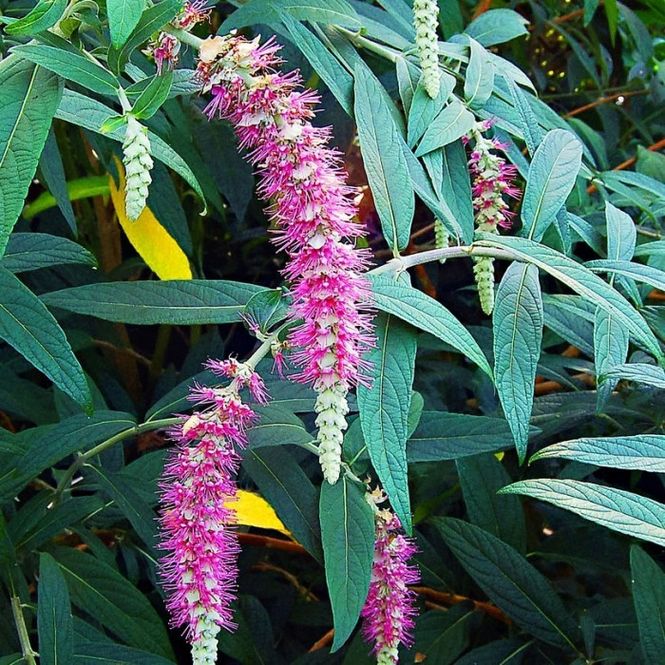
Last spring while browsing a website I noticed the name Rostrinucula dependens, common name ‘Weeping Buddleja’, though it’s unrelated to that genus. It was totally new to me and I had great difficulty in trying to pronounce it - it doesn’t trip off the tongue! It has a sister species, R. sinensis, both being natives of southern and central China, growing on hills and cliffs in Guangxi, Guizhou, Hubei and Hunan. According to Hillier’s Manual it was introduced only in 1985 which was quite a surprise! Of course I had to order a plant, but when it arrived it proved to be a rather scruffy specimen so I complained and was given 50% off!
I pruned it quite hard and within a short time it had produced a number of new shoots. Naturally I cut them all off and rooted them - why wouldn’t I! The original plant is growing on the bank above my house where it’s come through the last winter - it’s supposed to be reasonably hardy in most parts of Britain. This species apparently grows to 5 or 6ft and flowers in late summer and autumn. I don’t think mine will flower this year, but I’m very hopeful for 2024! It’s available from several UK nurseries, but I wouldn’t be surprised if it begins to appear in garden centres before too long. You could have the first one in your street!
July
Plant of the Month - Myosotidium hortensia
If you happened to find yourself wandering along the shoreline on one of the Chatham Islands, an isolated Pacific Ocean island group some 500 miles east of South Island, New Zealand, you might notice some spectacular evergreen perennial plants growing in the sand among the rocks. You would be astounded by the huge heads of bright blue flowers which you might have thought looked like giant forget-me-nots.
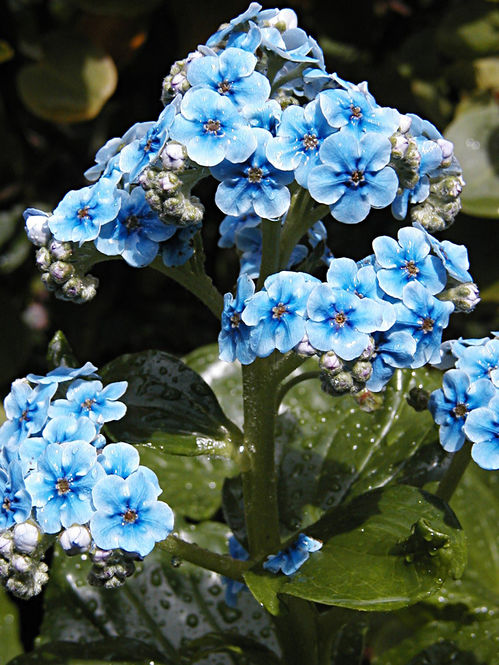
You would be right - Myosotidium hortensia, the Chatham Island forget-me-not, is endemic to those islands, but you might be surprised to hear that it can be grown outside in the UK, especially in milder areas. I first saw this plant growing in the garden of Tyninghame House, near Dunbar, many, many years ago. I’m not entirely sure when I first grew it, but records show that in 1996, four years after I’d began work at Arduaine, I obtained some seed, in a roundabout way, that came from a plant in the garden at Brodick, on the Isle of Arran.
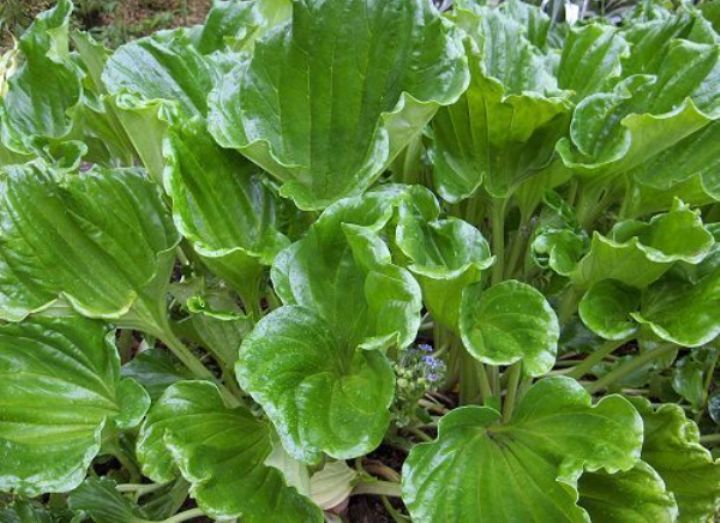
The resulting specimens were eventually planted out in a bed down beside the ponds, probably only 50 or 60 yards from the sea, where they grew to around two feet and flowered for many years. The foliage is dramatic - large, evergreen, ribbed and glossy. In flower they are even more dramatic - one of my favourite perennials of all time! A little later on I discovered that there was a white form and grew that for a while, though it couldn’t match the splendour of the original blue.
They are said to enjoy a diet of rotting fish, but if that’s unavailable then a well-drained but moist soil will do, maybe with a mulch over winter. In colder places they will do well in the conservatory, though the smell of rotting fish might be rather off-putting! Whichever way you can do it, it’s very well worth a try - if you can find one, that is!
June
Plant of the Month - Grevillea rosmarinifolia
We usually think of Australia as being a hot place whose native plants will not be hardy in the UK, but many plants from the south-east do well on Scotland’s west coast. I’ve grown several over the years, but one of my favourites is Grevillea rosmarinifolia, a shrub in the Protea family. It’s native to SE Australia, but apparently naturalised all over the continent.
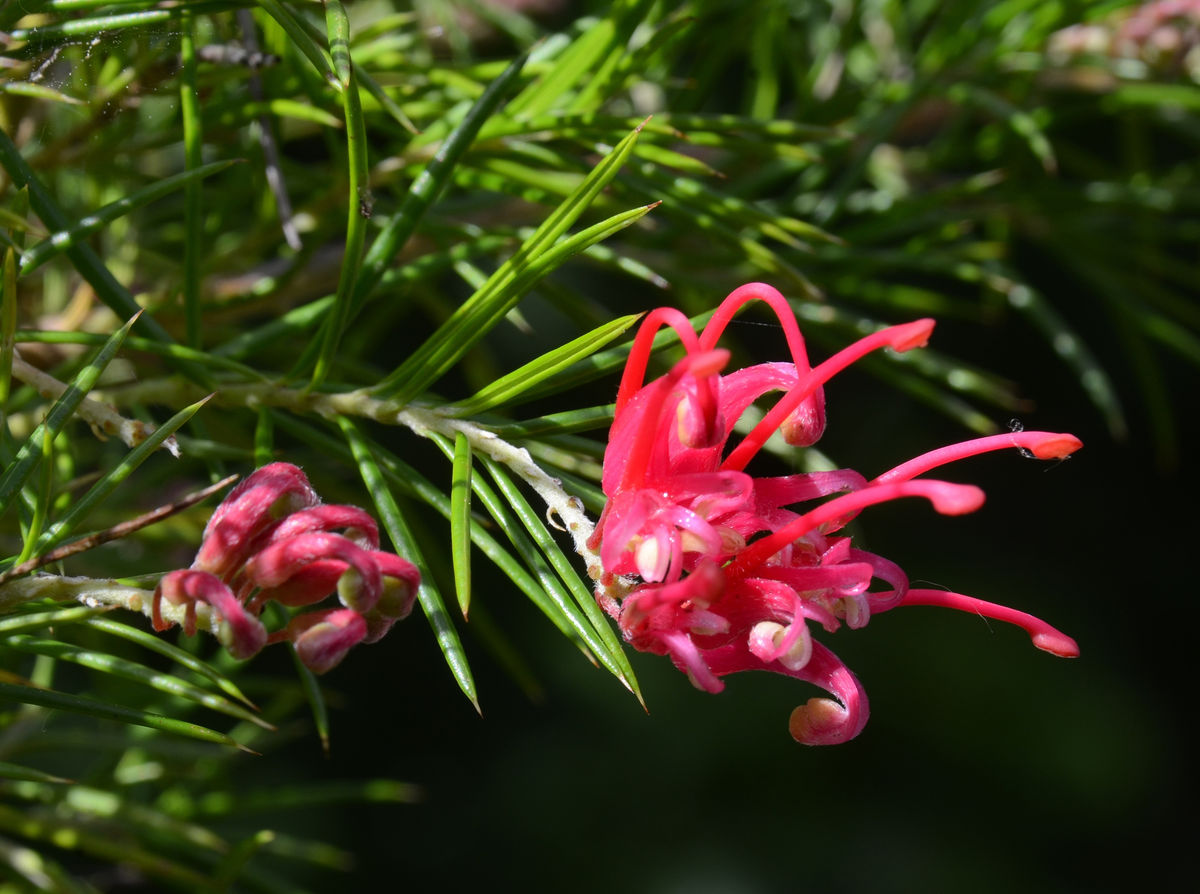
The foliage is short and spiky and quite similar to the well-known culinary shrub rosemary, hence the name. The flowers, however, are very distinct and exotic and described as red, though I would call them a very deep pink - I’ll leave you to decide from the photograph.
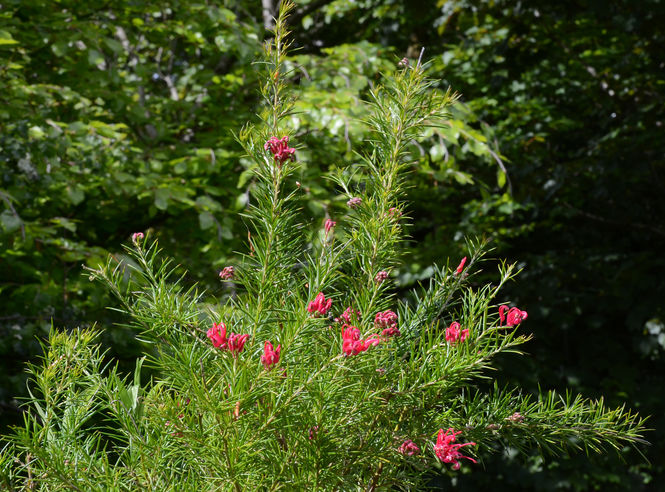
My plant is in a pot on the deck for the moment as I don’t have any wall space - my bungalow is surrounded by decking, gravel and paving just now, though I might need to make some changes. I’ve always assumed that it’s a plant for a warm wall, though I recently saw a lovely specimen in Dr Neil’s Garden at Duddingston in Edinburgh - quite a bit colder that Scotland’s West Coast, I would have thought!
It’s a medium-sized shrub, possibly up to 4- 5ft or so wide and high, and prefers a reasonably dry site and one with well-drained and rather hungry soil. Proteaceae generally are intolerant of phosphates so it’s best not to feed or mulch as you might with other shrubs.
Hillier’s Manual of Trees and Shrubs suggests that the Grevillea rosmarinifolia in cultivation is a hybrid with Grevillea lanigera, but if that’s the case I don’t let it worry me!
May
Plant of the Month - Euphorbia mellifera
The Euphorbia family is one of the largest in the plant world, with more than 2,000 members. Rather confusingly these range from small annuals, to perennials, shrubs, cacti and succulents and even trees! I have a funny feeling that somewhere out there is a taxonomist who is eyeing them up, thinking that the family should be divided into numerous differently named species! But I hope that I’m wrong.
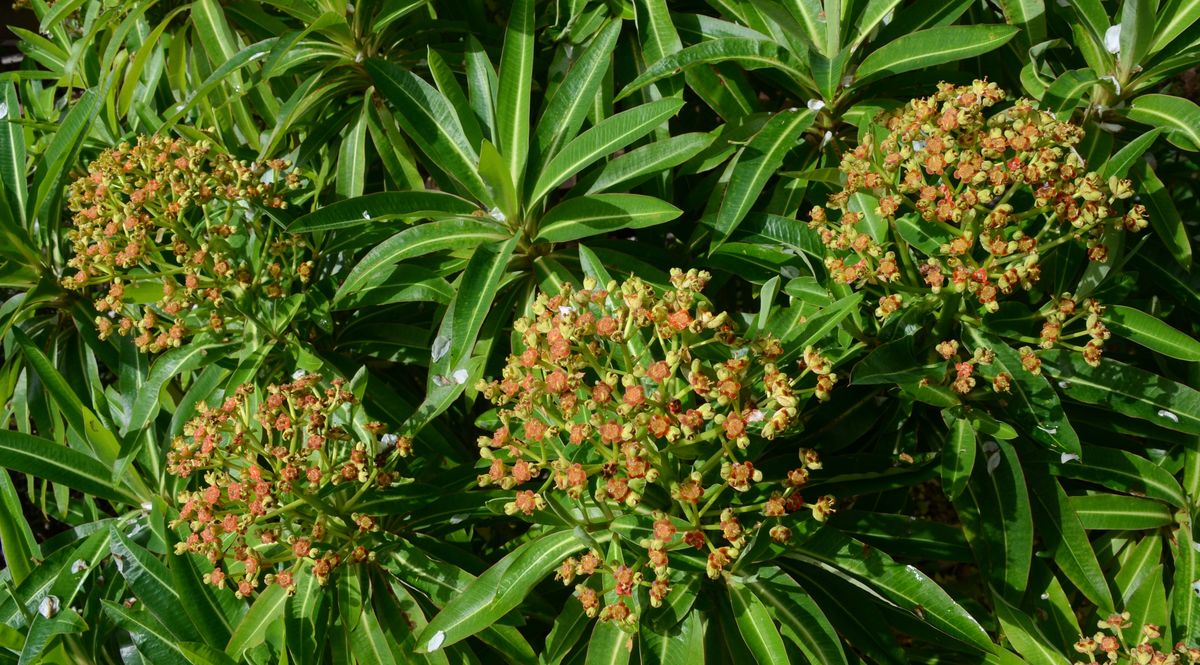
Euphorbia mellifera is a true shrub, hailing from Madeira and the Canary Islands, and seems quite hardy here on the west coast, though it might need protection further inland. Its common name is the Honey Spurge, spurge being the everyday name for euphorbias in general. The flowers, which are produced in early spring, are orangey-brown, have a wonderful honey fragrance and are followed by clusters of small, pea-like seeds. This shrub, which is of medium to maybe large size, is rounded in shape and evergreen, and the foliage is attractive in its own right, being long, narrow and acid-green, with a pale stripe down the centre.
Euphorbia mellifera was already growing at Arduaine when I arrived there in 1992 and continued to flourish, producing quite a number of self-sown seedlings. One of these seedlings is doing very well in my garden in Oban and has flowered well this year. Probably the only downside is the fact that in common with all euphorbias this shrub has a white, irritant sap which should be kept away from skin and eyes. It’s supposedly harmful if eaten, though I have to say that I’ve never tried it!
All round a beautiful shrub for a sunny spot and very easy to grow. Give it a try!
April
Plant of the Month - Bilbergia nutans
As I mentioned last month, plants are loosely classified into informal groups, one being the bromeliad. Members of this group are rarely seen growing outdoors in our climate, though Fascicularia and Puya are both possibilities. The best known in the group is probably the pineapple, Ananas comosus, but there are a number of other genera which can be grown as houseplants - Vriesea and Aechmea are two that are often seen in garden centres.
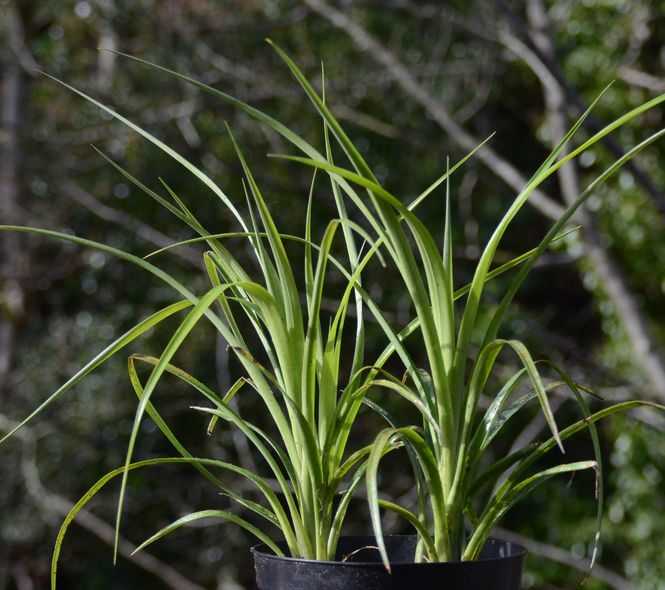
A bromeliad that I’ve grown under glass over the years is Bilbergia nutans, sometimes known as Queen’s tears; I don’t know which queen did the crying! It had never occurred to me that it might be reasonably hardy as it’s native to Central and Southern America, where like most bromeliads it’s generally seen perching in the forks of trees. With a limited root run the plants collect rainwater in their rosettes.
Some years ago I thought I’d experiment with a specimen that I had in the glasshouse at Arduaine. It was quite a sizeable one, so one spring I took it out of its pot and squeezed the rootball into the fork of an old willow tree, where I tied it in place to prevent it being blown out before the roots got a grip. It was still alive and looking fine when I retired a few years later, so I think it’s worth a try here in Oban.
I have several plants which have been sitting in pots under the eaves of the house for a few years, so I’ll look for some sites for them. As with many plants of borderline hardiness it’s best to get them out just as soon as the threat of heavy frost is past, to give them a long growing season before the next winter.
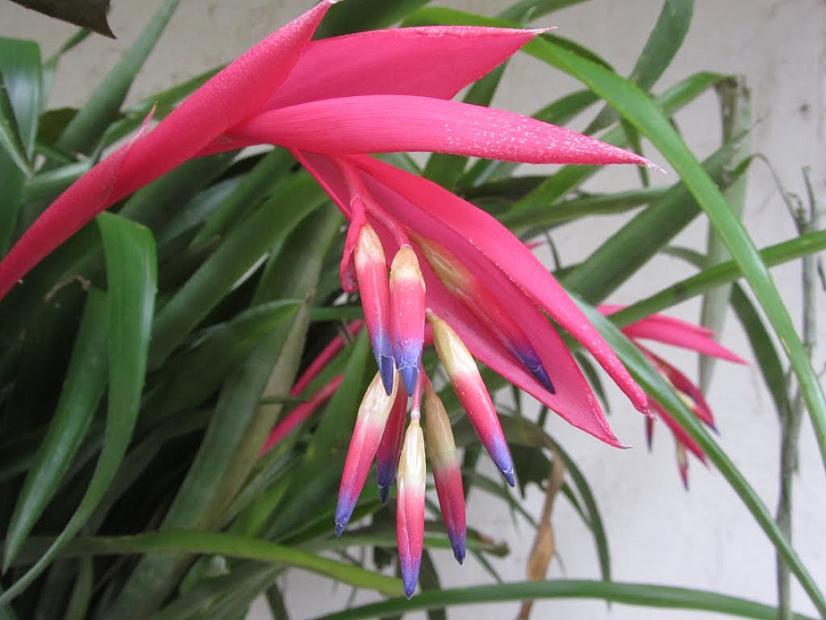
March
Plant of the Month - Wollemia nobilis
Well, so far I’ve talked about an indoor plant, a shrub, a tuberous perennial and a fern, so this time we’ll have a conifer. Now there are conifers and conifers, huge species and dwarf varieties, deciduous and evergreen, long-known and recently discovered.
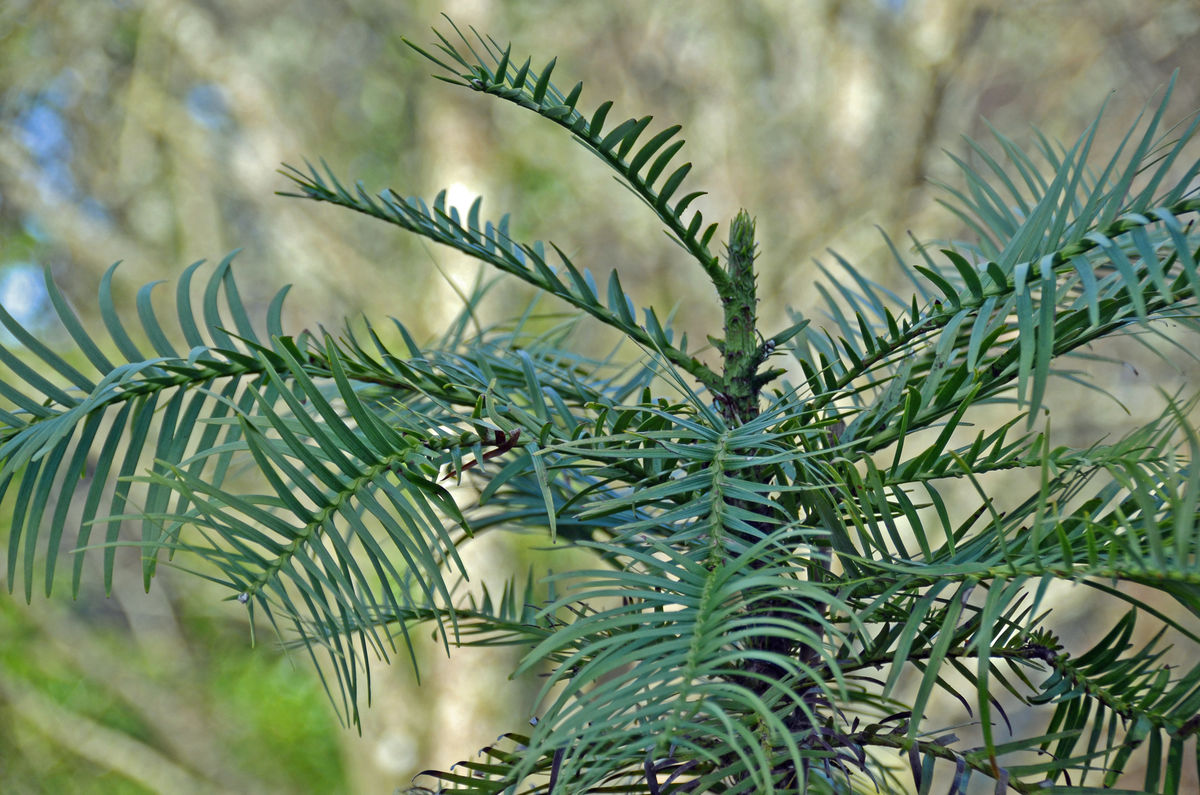
Wollemia nobilis, known as the Wollemi Pine, comes under the latter category; it shares a family with the Monkey Puzzle tree. I find it really hard to imagine, but it was first discovered only in 1994, no, not 1894, 1994, and just 125 miles NW of Sydney, Australia! To quote the website - “Wollemi Pines are restricted to approximately 40 adult and 200 juvenile trees growing in the Wollemi National Park of New South Wales.”
They grow in deep gorges and were discovered by David Noble while abseiling into one of the gorges, a popular sport in the area. Apparently he didn’t recognise them and took a piece back to a botanist friend who must have had a fit - they were thought to have been extinct for two million years!
They’ve been on the market since 2004 and I bought one for Arduaine. They are certainly the ‘must have’ plant these days and are generally hardy in the UK. I even have one in my Oban garden, given to me by a friend who had rooted it from a double leader on his tree. Unfortunately a roe deer chewed the top off and uprooted it, but it’s back in the ground again and growing happily. They do eventually grow to a large size, so don’t plant it in front of the living room window! Since writing this I’ve decided to donate my plant to the garden at Dunollie, in Oban, where they have a little more room to grow a potentially large conifer than I do!
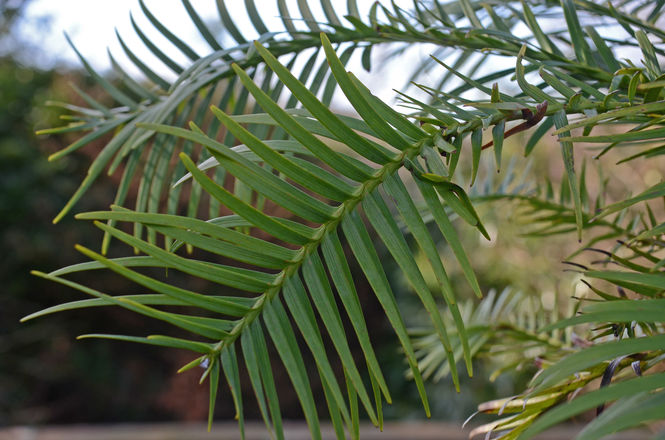
February
Plant of the Month - Lophosoria quadripinnata
Someone once told me ‘All ferns are bracken’! I had the opportunity to plant a large collection of ferns at Arduaine, ranging from tiny species which grow in cracks in the rocks to tree ferns, which can grow extremely tall, and of an infinite number of frond shapes, colours and textures, so I knew this was not the case! This month my blog is about one of the tallest of the ‘non-tree’ ferns, Lophosoria quadripinnata.
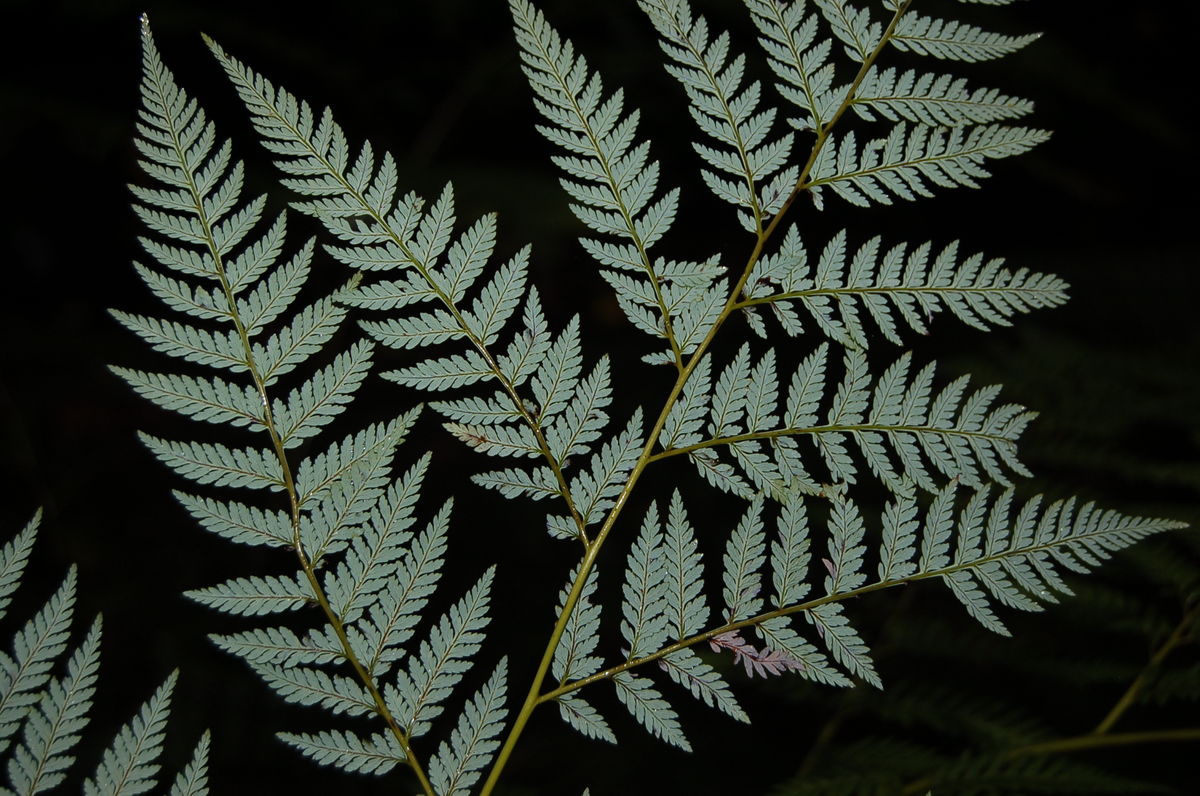
Many years ago the Royal Botanic Gardens in Edinburgh gave me three tiny Lophosoria in 3” pots, which I grew on for some time before planting out. It’s a magnificent species which eventually grew very large at Arduaine, planted in a shaded and sheltered spot. The fronds were something in the region of 10-12ft tall and one day, after taking several photographs which really didn’t show its size, I walked out to the path and asked a couple of ladies if they would be prepared to follow me into the woods for a photograph! I explained that they were wanted to show scale, and so they agreed! I’ve shown the picture here, not great quality, but it came from a scanned slide. This fern is native to Central and South America and is hardier than generally supposed. On a visit to Chile in 2005 I saw this fern everywhere, in woodlands, beside waterfalls and even growing in tubs outside a petrol station!
Apart from its size the most striking feature of this fern is the underside of the frond which is a beautiful pale metallic blue, glaucous I suppose you might call it. The unfurling fronds too are quite amazing and as the plants grows larger these become quite dramatic. Give it a go in a sheltered spot and be the envy of the neighbours!
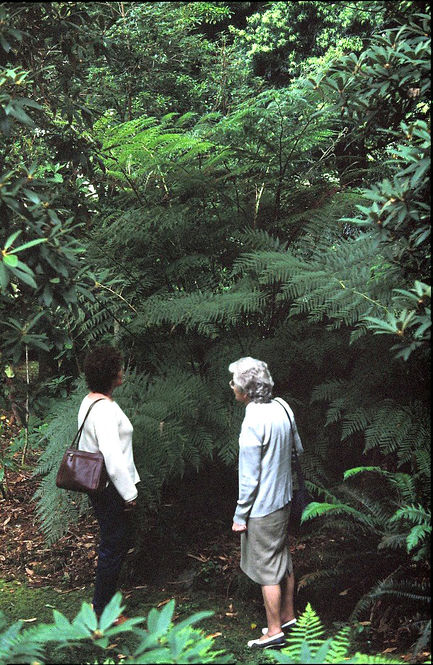
January
Plant of the Month - Leycesteria crocothyrsos
Many of us are familiar with Leycesteria formosa, the commonly called Pheasant Berry or Himalayan honeysuckle, which though an attractive shrub seeds around everywhere and is becoming a pest in many areas including Scotland - Oban has loads of it. Never fear - there’s an even more attractive alternative!
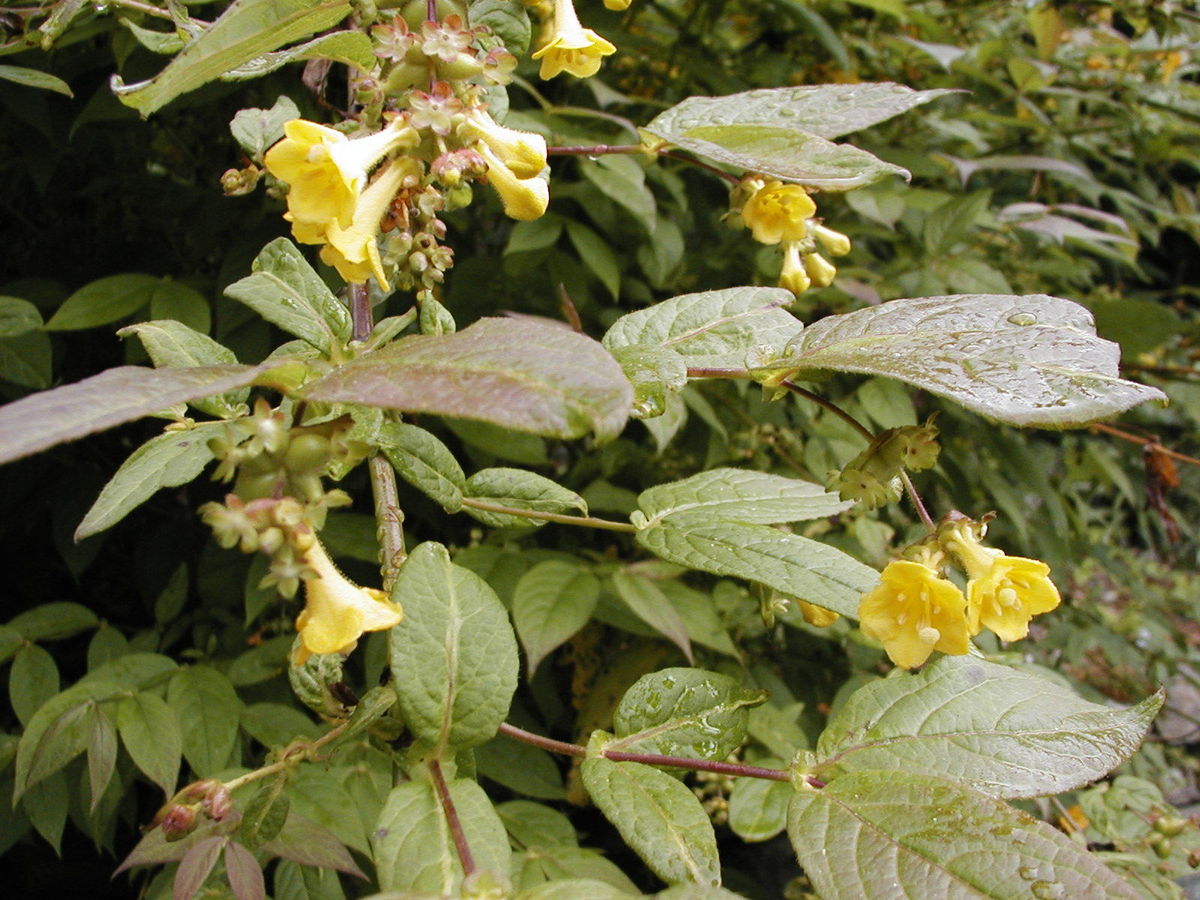
The Pheasant Berry’s sister species, Leycesteria crocothyrsos, is less hardy and more difficult to pronounce, which are probably both reasons for its scarcity, but I grew it for a number of years at Arduaine without frost damage so it’s well worth trying. I remember seeing this species for the first time at Logan Botanic Gardens, where it grew on the terrace at the top of the garden - I just had to have it! It’s a deciduous shrub with fairly large, bronzy, slender pointed leaves on hollow stems. The flowers are similar in shape to those of its sister, but of a most beautiful golden yellow, borne in pendulous terminal racemes and followed by small green berries. OK, the berries may not be as attractive as the purple-red ones of L. formosa, but you can’t have everything!
It deserves a sheltered spot and grows to around 5-6ft, or a couple of metres to younger enthusiasts! It’s a native of northern India (Assam) and round about, including northern Myanmar, which of course was Burma in the old days! It was originally introduced in 1928 by Frank Kingdon-Ward, and again more recently by Roy Lancaster. Plants grown from his seed collection are reputed to be hardier. Go on - give it a go!

December
Plant of the Month - Bomarea edulis (Salsilla)

I’m not sure what attracted me to the generally twining genus Bomarea, related to the better-known Alstromeria, but I’ve grown several of the species over the years. The only one that I grow now is Bomarea edulis, which as its name suggests, is edible, or rather the tubers are. They’re supposed to taste like Jerusalem artichokes, but as I’ve never knowingly eaten one of those I can’t really comment!
This plant has a wide distribution through Central and South America, probably widened through its cultivation, but it was first discovered in 1768 in Rio de Janeiro by botanists on Captain Cook’s ship, the Endeavour.
It seems quite hardy in my Oban garden, which in spite of what the weather websites say does get a fair amount of frost, being some 220ft above sea level. My plant is still in a large clay pot though maybe next spring I will plant it out to scramble up a shrub or on a trellis on the house wall.
A herbaceous climber, it grows annually to 6-8ft, supported on tall canes. The leaves are simple and lanceolate and the flowers are narrowly tubular, salmon pink outside and yellow and green with purple dots inside. The bursting seeds pods are spectacular too! Mine was still flowering outside in the middle of November and is only just beginning to die back. In colder places the pot could be overwintered in a greenhouse or frame, but mine has stood outside here for the last six winters. One day I might try eating one of the tubers!
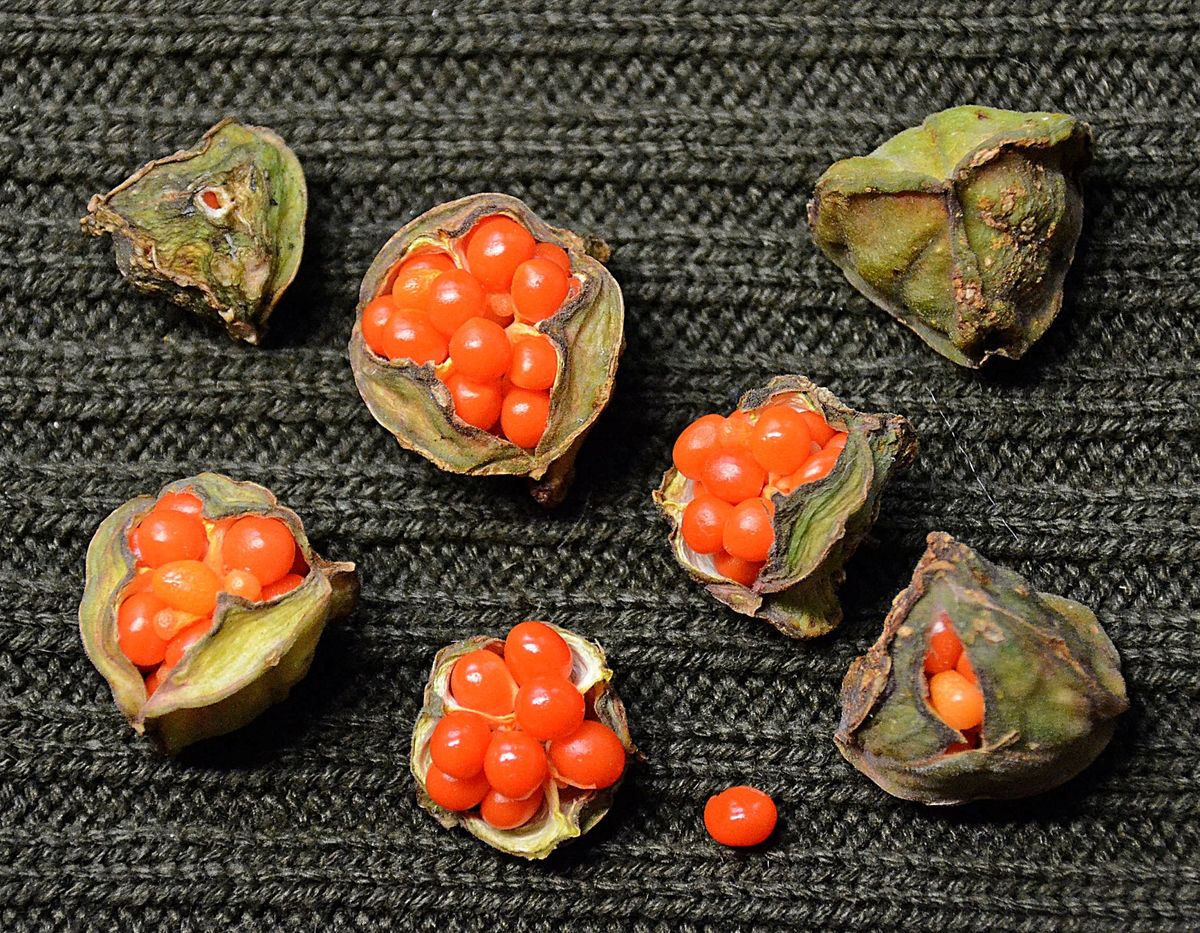
November
Plant of the Month - Begonia hatacoa PGG 209
I’m going to begin this blog with a plant which is very special to me and which is not commonly grown. It’s a begonia, a species by the name of Begonia hatacoa PGG 209, which is a native to several countries in the Far East.

The suffix PGG 209 indicates that it was collected in the wild, the PGG standing for Professional Gardeners’ Guild, a group of colleagues I travelled with. It was in fact grown from seed which I collected in Nepal on 3rd November 1990, and I’ve propagated it from cuttings ever since so that all resultant plants can legally bear the suffix PGG 209.
It’s not very hardy, so I keep it as a houseplant where it enjoys a light position, out of hot sun; it can be grown outside during the summer. I didn’t know which species it was when I saw it, so my collecting notes say “Begonia species, growing in deep shade on a steep bank, between Sekathum and Chirwa, altitude 1500m. Foliage 12cms x 7cms, pale green, glossy.”
I identified it later on, once it had flowered, and because of its wild origin, Glasgow Botanic Garden was prepared to accept it into their National Begonia Collection. Not the most spectacular of begonias maybe, but it means a lot to me and will always remind me of tramping through the deep, dark forests of Nepal!
About the author

At the age of seventeen Maurice decided on a complete change of career, from a civil servant to a gardener, and has never looked back!
After a few years’ employment with a garden contractor in Surrey he worked in the Woodland Garden in Bushy Park, Hampton Court, in the garden at Holyrood Palace in Edinburgh and then took up his first Head Gardener post at Ross Priory on Loch Lomond.
After sixteen years there he moved westwards to manage Arduaine Garden (and Crarae Garden too for a couple of years) in Argyll, from where he retired after twenty-four years in 2016.
He has spent many years leading garden tours, has been plant hunting in Chile and the Himalayas, and finally settled down to grow unusual plants on a cliff in Oban!



